An ecological approach to manage gut health in turkeys

Chicken sexing through beak morphometry
Behaviour of pullets and housing system predicts behaviour of adult laying hens in commercial free-range egg farms
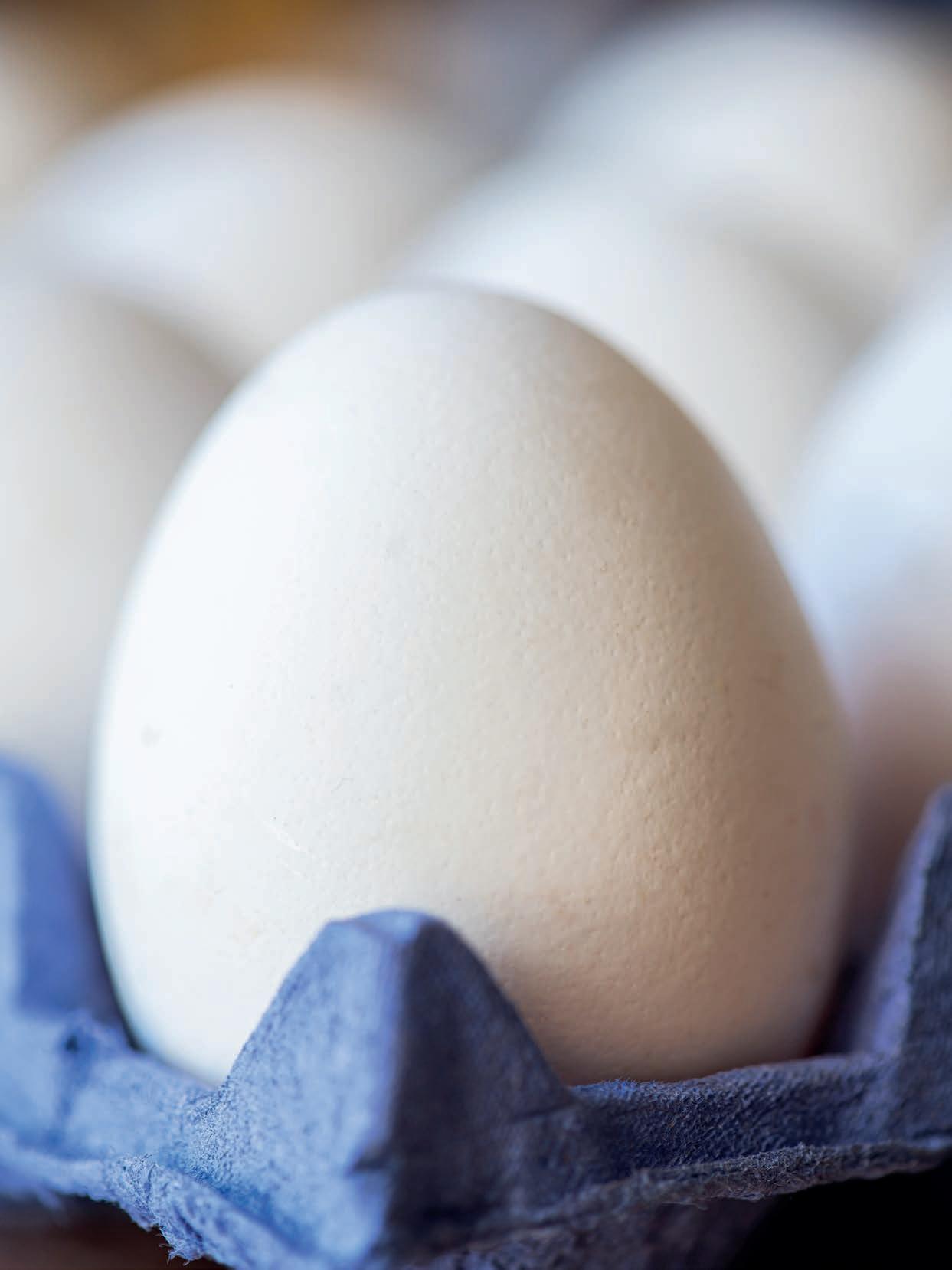
12 2022 Zootecnica International –December 2022 –POSTE ITALIANE Spa –Spedizione in Abbonamento Postale 70%, Firenze
The
new feeders of the «Gió» range, specifically developed for great poultry farms, thanks to the easiness in the regulation of the feed and to the absence of grill (that avoid chicks perching) have many advantages: they are easy to use and their cleaning is extremely easy and fast too, leading to an overall reduction in labour costs.


CODAF Poultry Equipment Manufacturers • Via Cavour, 74/76 • 25010 Isorella (Brescia), ITALY Tel. +39 030 9958156 • Fax: +39 030 9952810 • info@codaf.net • www.codaf.net
EDITORIAL
On the occasion of the BioEnergy Decentral Fair which was held a few years ago in Hanover, Germany, I collected informative material regarding the energy supply of the future.
Today this topic is more relevant than ever. Among the various concepts and technical solutions proposed, I found those developed by VDMA Power Systems of Frankfurt particularly interesting. VDMA is an organization that represents the economic, technical and scientific interests of the mechanical engineering industry in Germany and Europe.
The growing need for renewable energy will make it increasingly necessary to decentralize supply and the need for flexibility within the entire system increases considerably. Hybrid production plants will play a central role as they are able to supply power balancing the difference for demand and the production of electricity from sources not regularly available (for example, from solar and wind energy).
Decentralized production plants rely on combustion engines and turbines; they can guarantee safe and reliable production in a short time. They can operate in combination with large power plants which is necessary in order to cover consumer demands.
In Germany, many municipalities and farms have recognized the validity of high-efficiency power plants, which optimizes consumption, by designing and installing their own energy supply system.
This VDMA concept could be able to resolve well known compatibility disputes particularly when such a change in the supply of energy would not be jeopardized by high costs and technical problems.
But these solutions go into the hands of politicians, to be approved and, as we know, into the hands of the bureaucracy. No comment.

4002 H
• 360 degrees opening
• Highly strong and durable material
• “SOFT” action
4626

• Suitable for fattening turkeys
• Perfectly dry bedding
• Simultaneous watering of 2 and more animals
for breeding
PP Belts
• Egg collection
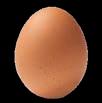

• Manure drying system

• Manure belt collection
• PP woven egg belts



• PP hole egg belts
4006 H
• 360 degrees opening



• Highly strong and durable material
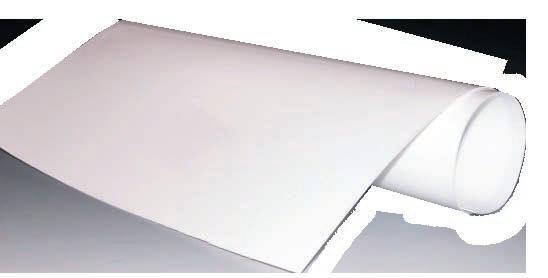
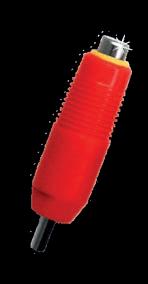
• “EXTRASOFT” action
4901 N
• Essential design
• No chicks in the pan!
• Regulation of minimun and maximum feed level


• Available in caged broilers version
Pressure regulator with bypass
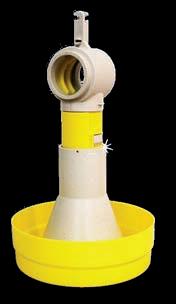

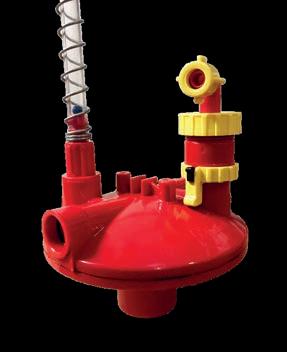

INFINITY
CORTI ZOOTECNICI
ARTICLES ACCESSORIES
Corti Zootecnici Srl | Via Volta, 4 21020 Monvalle (VA) Italy| www.cortizootecnici.it |



SUMMARY WORLDWIDE NEWS 4 COMPANY NEWS 10 DOSSIER An ecological approach to manage gut health in turkeys 14 MARKETING Dynamics and patterns of the poultry industry in the G19 countries between 2010 and 2020. Part 1 – Poultry meat production 22 TECHNICAL COLUMN Chicken sexing through beak morphometry 28 MANAGEMENT Behaviour of pullets and housing system predicts behaviour of adult laying hens in commercial free-range egg farms 30 NUTRITION Probiotics, immunity, and gut health. How does the microbiome influence health and what can we do to support it? 36 VETERINARY Case studies of re-emerging bacterial diseases in cage-free and organic flocks 38 PROCESSING Maintaining the inside-outside bird washer for optimal hygiene 42 MARKET GUIDE................................................................................44 UPCOMING EVENTS 47 INTERNET GUIDE 48 30 14 28
Avian Influenza: unprecedented number of summer cases in Europe
An unprecedented number of highly pathogenic Avian Influenza (HPAI) virus detections were reported in wild and domestic birds from June to September in Europe, according to the latest overview by EFSA, the European Centre for Disease Prevention and Control, and the EU reference laboratory. In previous years, no cases or only a few cases were detected during the summer period. The overall 2021–2022 HPAI season has produced the largest epidemic so far observed in Europe.
Between 11 June and 9 September 2022, 788 HPAI virus detections were reported in 16 EU/EEA countries and the United Kingdom with 56 in poultry, 22 and 710 in captive and wild birds, respectively. The unusual persistence in wild birds continued throughout the summer and occurred in 15 European countries. The virus reached sea bird breeding colonies on the north Atlantic coast, causing massive mortality, particularly in Germany, France, Netherlands, and the UK.
Heavily infected wild birds presented an ongoing risk of infection for domestic birds too. From June to September, the number of outbreaks in domestic birds declined com-
pared to previous months, but was more than five times higher compared to the same period the year before.
“With cases detected in poultry and wild birds up to September, the current epidemic is clearly still ongoing. As autumn migration begins and the number of wild birds wintering in Europe increases, they are likely at higher risk of HPAI infection than previous years due to the observed persistence of the virus in Europe”, said Guilhem de Seze, Head of the Risk Assessment Production Department at EFSA .
EFSA recommends the rapid implementation of suitable and sustainable HPAI mitigation strategies, including ap -
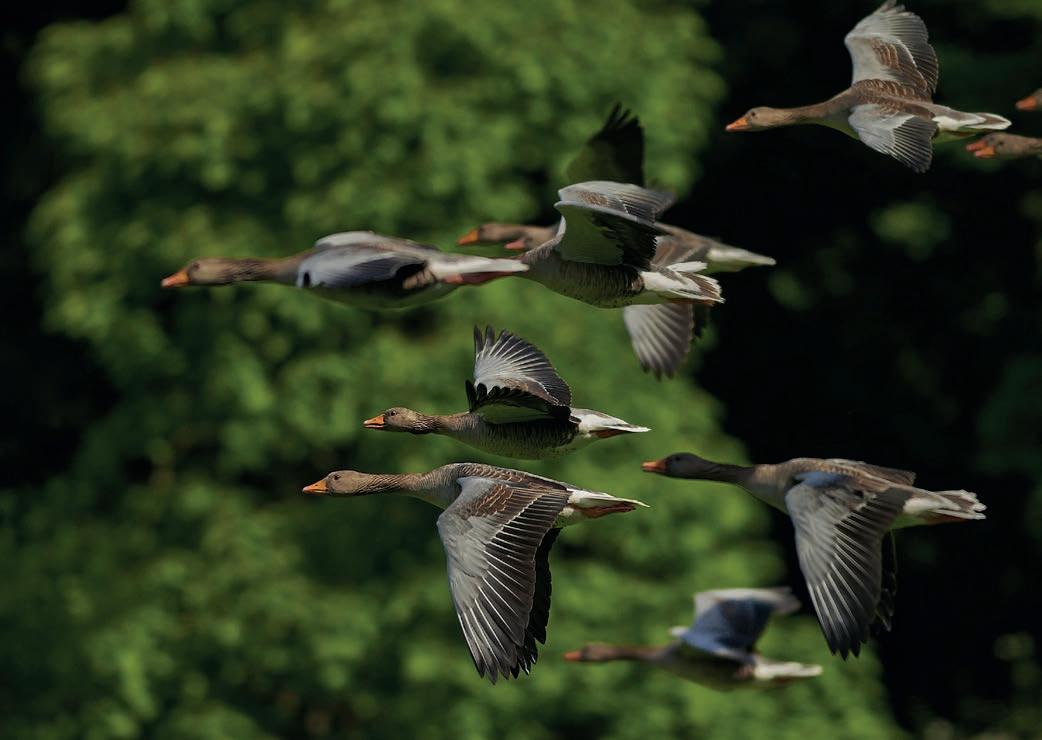
4 - worldwide newsWORLDWIDE NEWS
propriate biosecurity measures and surveillance strategies for early detection. Medium to long-term prevention strategies should be considered in densely populated areas and in poultry production systems highly susceptible to Avian Influenza exposure.
Unprecedented geographical reach
The ongoing HPAI season has produced the largest epidemic seen so far in Europe, with a total of 2,467 outbreaks in poultry and 47.7 million birds culled in affected establishments. In addition, 187 detections were notified in captive birds and 3,573 HPAI events were recorded in wild birds. The geographical reach of this year’s epidemic is unprecedented, with reported cases ranging from the Svalbard islands in Norway to southern Portugal, and as far east as Ukraine, affecting 37 European countries in total.
In autumn 2021, the HPAI A(H5N1) virus also crossed the Atlantic Ocean for the first time, spreading from Europe
to North America along migration routes and causing a severe epidemic in poultry in several Canadian provinces and US States as well as causing mortality in wild birds.
Low risk for people
The European Centre for Disease Prevention and Control (ECDC), having also contributed to the report, concludes that the risk of infection for the general human population in the EU/EEA is low, and low to medium for occupationally exposed people, with high uncertainty due to the high diversity of circulating avian influenza viruses in bird populations. The risk of transmission to humans by exposure to contaminated poultry products is considered negligible.
In addition, ECDC has published a technical report on ‘Testing and detection of zoonotic influenza virus infections in humans in the EU/EEA’, to which EFSA, the EU reference laboratory and the European Agency for Safety and Health at work have also contributed.
The Poultry Research Foundation, in conjunction with WPSA - Australian Branch announced the 34th Australian Poultry Science Symposium at Sheraton Grand Sydney Hyde Park
“Although our plans for a hybrid event did not come to fruition for APSS 2022, we have made the decision that APSS 2023 will move back to the Sheraton Grand Sydney and revert to our usual face-to-face format. The 2021 and 2022 Virtual Conference’s were very well received, with around 300 delegates tuning in over the event dates, but with National and Global travel restrictions being eased, it's time we all came together again in Sydney.
The Australian Poultry Science Symposium is the premier avian science conference in Australia, attracting delegates from right across the country and around the world. This year the conference will focus on an over-arching theme of: “Global Volatility and Poultry Industry Sustainability”.

As always, APSS will continue to include an array of excellent invited speakers to feature at the event, as well provide our delegates plenty of time to network and socialise by offering a lively social program. This year will be a 2.5 day program with AVPA Conference to follow on the Wednesday afternoon.”
Dates: Monday 6 th Feb - Wednesday 8 th Feb, 2023
For more information contact: https://www.apss2023. com.au
- december 2022 - 5 WORLDWIDE NEWS
Trial with three vaccines against bird flu
Wageningen Bioveterinary Research (WBVR) has started a trial with bird flu vaccination. In Lelystad vaccines against bird flu of three different pharmaceutical companies are tested.

were free of bird flu infections. This year, for the first time ever, the virus didn’t leave the Netherlands with the migrating birds during springtime. The virus was able to infect birds which stay in our country during summer. This means that the virus is still spreading via bird droppings from infected birds and therefore poultry farms were still infected.” For the poultry farmers in The Netherlands this has major consequences. Since October 2021, infected poultry farms were culled, transport restrictions were in place and flocks were kept indoors to prevent infection.
Solution against bird flu
In the trial vaccines against the current H5 viruses are tested in laying hens. “More information about the potential vaccines against bird flu is required before these can be applied in the field,” explains bird flu researcher Nancy Beerens at WBVR. The research is done under commission of the Dutch ministry of Agriculture, Nature and Food Quality.
This first vaccine trial is performed in the animal facilities in the high containment unit of WBVR. The modern vaccines were developed by three different pharmaceutical companies; the tested vaccines are based on different technologies. “In this trial we test the effect of the vaccines on clinical signs of disease. Furthermore the effectivity of the vaccines against the spread of the virus is an important parameter of the study,” says Beerens. “The trial will run for about three months after which data will be analysed. We don’t expect the final results before the second half of December.”
Prolonged bird flu season
The call for a vaccine in the battle against bird flu is getting louder, notes Beerens. “Previously, our summers
Vaccination of poultry flocks has many pros and cons. “Bird flu vaccines have to protect against disease but also need to prevent the spread of the virus. If a vaccinated flock gets infected with bird flu but the birds show no signs of illness, a farmer wouldn’t notice the virus infection. If, in that case the vaccine is not effective enough in reducing virus transmission, this could potentially cause ‘silent’ spread of the virus between farms”, explains Beerens. This aspect is one of the reasons why the European Union has rules in place for vaccinated poultry.
“We expect that the new types of vaccines we are testing in this trial, provide better protection against the spread of the virus than previous vaccines. Furthermore, it is possible to distinguish between vaccinated and infected animals with specific diagnostic tests.” Several European countries have started bird flu vaccination studies. “The results of these studies are very important for preparing future European agricultural policy which possible allow vaccination of poultry.”
First step
The bird flu vaccination research at WBVR is the first step in research aimed to combat bird flu with vaccination. The information obtained from this research will be used for future research, such as a field trial.
Source: Wageningen University & Research
6 - worldwide newsWORLDWIDE NEWS
Leader in pig & poultry equipment




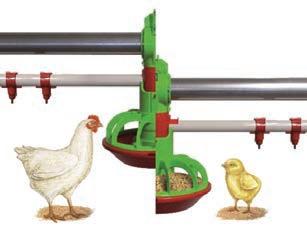
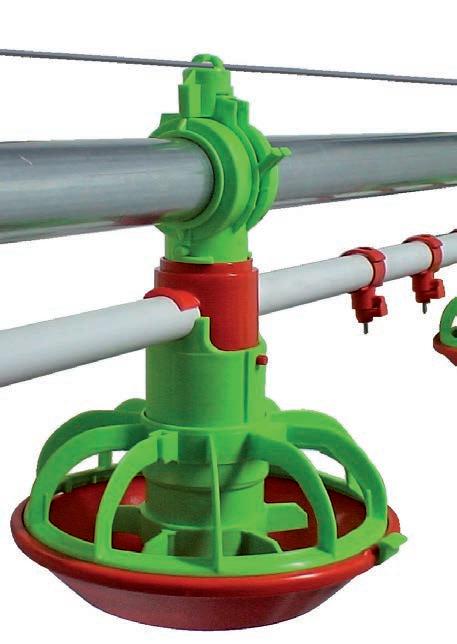

Lower bottom pan from one-day old to slaughtering age.
Six feed level adjustments. COMPETITIVE PRICE.
Specific model for cages on request. The feed level adjustment is

FULLY AUTOMATIC
THE BROILER FEED PAN
ONE SECOND to open the pan for complete and fast washing.
Only one winching system for two lines. More space in the shed.
Designed from one-day old to slaughtering age.
The adjustment of the feed and water level is
AUTOMATIC
- december 2022 - 7 WORLDWIDE NEWS Via Roma 29, 24030 Medolago (BG) Italy - Phone +39 035 901240 - info@azainternational.it www.azainternational.it I WANT AZA!
DUO THE PERFECT COUPLING BETWEEN FEED AND
WATER FOR BROILERS
PRATIKA
QUALITY MADE IN ITALY
Researchers evaluate a novel feed additive to reduce the incidence of wooden breast
USPOULTRY and the USPOULTRY Foundation announce the completion of a funded research project at the University of Delaware in which researchers evaluated a novel feed additive to reduce the incidence of wooden breast.
effective approaches to prevent or treat this disease. This project aimed to prevent or diminish deleterious changes in the breast muscle using benfotiamine, a derivative of thiamine with higher bioavailability.
Benfotiamine has been previously studied in humans for its therapeutic effects on preventing vascular endothelial dysfunction and oxidative stress in individuals with Type 2 diabetes. Considering metabolic similarities between WB and Type 2 diabetes, the current study hypothesized that benfotiamine may be beneficial for reducing the incidence of WB in commercial broiler chickens.
The research (principal investigator: Dr. Behnam Abashwas) made possible in part by an endowing Foundation gift from Mountaire Farms and proceeds from the International Poultry Expo, part of the International Production & Processing Expo (IPPE).
Feed additive for reducing incidence of wooden breast disease in commercial broiler chickens

Wooden Breast (WB) is a degenerative muscle disease of modern broiler chickens characterized by extreme firmness of the breast muscles, significantly affecting meat quality. Despite the disease prevalence and the fact that chicken producers have expressed immense interest in a timely and economic solution, there are currently no
Findings from the current study indicated that feed supplemented with benfotiamine resulted in a significant reduction in the severity of both WB and white striping. Feed supplemented with benfotiamine had no significant effect on body weight until 42 days post-hatch. There was a slight but significant reduction (4.8%) in body weight at 55 days post-hatch in chickens receiving benfotiamine. Histologic analyses of pectoralis (p.) major muscle specimens showed that compared with control chickens, treatment birds exhibited decreased severity of myopathic lesions, as well as a lower incidence of vacuolations, lipogranuloma formation, myofiber splitting, myofiber regeneration, fibrosis and necrosis.
These results are consistent with the decreased severity of clinical (palpable) WB in the treatment group and suggest beneficial effects of benfotiamine in reducing the severity and prevalence of muscle lesions in fast-growing broiler chickens. Molecular analyses are ongoing to understand the effects of benfotiamine on biological mechanisms and pathways in the p. major muscle. The current study examined a single level of benfotiamine throughout the entire growth period (from day one to week eight). Therefore, future studies with different concentrations and duration of using benfotiamine will be beneficial in determining an optimal level and duration for supplementing chicken feed with benfotiamine.
Source: USPOULTRY
8 - worldwide newsWORLDWIDE NEWS
Fiberglass silos: the most practical, effective and durable solution to any bulk storage requirement


Agritech s.r.l. Via Rimembranze, 7 25012 Calvisano (BS) Italy
Tel. + 39 030 9968222 r.a.
Fax + 39 030 9968444
commerce@agritech.it
www.agritech.it
- december 2022 - 9 WORLDWIDE NEWS
Till 40 silos in 1x40’ O/T container
Till 23 silos in one complete truckload
Aviagen Group Invests R$ 50 million to secure supply of Hubbard broiler breeders in Latin America
Doubling capacity of Brazil’s Luziânia operation will enable Hubbard to keep up with a growing demand for healthy broiler breeding stock.
the production capacity of Efficiency Plus for the Brazilian market. A subsidiary of Aviagen Group, Hubbard operates independently as a broiler breeding company with its own breeding and commercial activities.
Latin America – dynamic and growing region
The Aviagen Group ® has announced an investment of R$ 50 million ($9,5 million USD) to expand its Luziânia operations in the state of Goiás, Brazil. Luziânia produces Hubbard ® Efficiency Plus broiler breeding stock. Scheduled for completion in 2024, the expansion will double
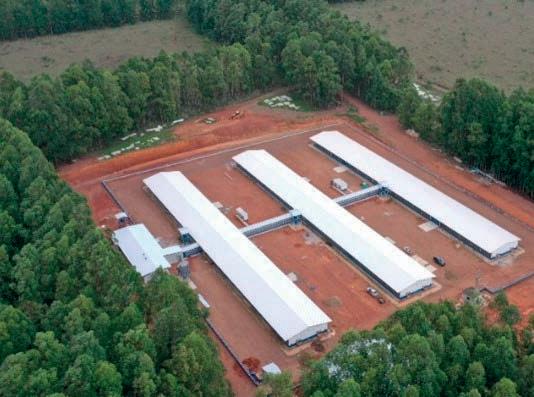
Carlos Antônio Costa, Brazil General Manager, Hubbard, affirmed his company’s dedication to the poultry market in Brazil. “We are committed to our Hubbard customers in Brazil and throughout Latin America, and this expansion will help further secure the supply of broiler breeding stock,” he commented. “The robust Efficiency Plus strengthens the market with its excellent feed efficiency, disease resistance, livability and productivity at both the breeder and broiler levels. The Hubbard Efficiency Plus has the right balance of qualities to ensure the success of Hubbard customers,” said Costa. “The poultry industry in Latin America has a future of continuous growth, and our investment in this region will be ongoing to keep pace with this growth.”
Second-in-a-row Nick French Award for Matthias Corion of Belgium
The award was introduced in 2019 to recognize innovative young scientists in honor of retired Global Head of Technical Transfer Nick French and his lifelong contribution to the industry, and to hatchery and incubation research in particular.
Aviagen recently honored Ir. Matthias Corion with the 2022 Nick French Award. Matthias is a PhD student in the Department of Biosystems at the University of Leuven in Belgium, and this is his second year to take home the award. Winning research presentations are selected by the Committee of the Incubation and Fertility Research Group (IFRG) of the World Poultry Science Association (WPSA). Matthias’s presentation was entitled, “Determining the fertility and
10 - company newsCOMPANY NEWS
Aviagen Group’s Luziânia operation in Goiás, Brazil, produces Hubbard Efficiency Plus birds
the sex of chicken hatching eggs using a new volatile organic compound extraction approach” with a goal of accurate sex identification in ovo









“We congratulate Matthias on this prestigious accomplishment, and am very impressed with his passion and drive to improve our understanding of the science underlying a very
new approach to understanding embryo development”, said Dinah Nicholson, Global Head of Hatchery Service and Support. “Aviagen is committed to supporting our next generation of poultry industry talent – they are the future of our industry and we must encourage and support them.”
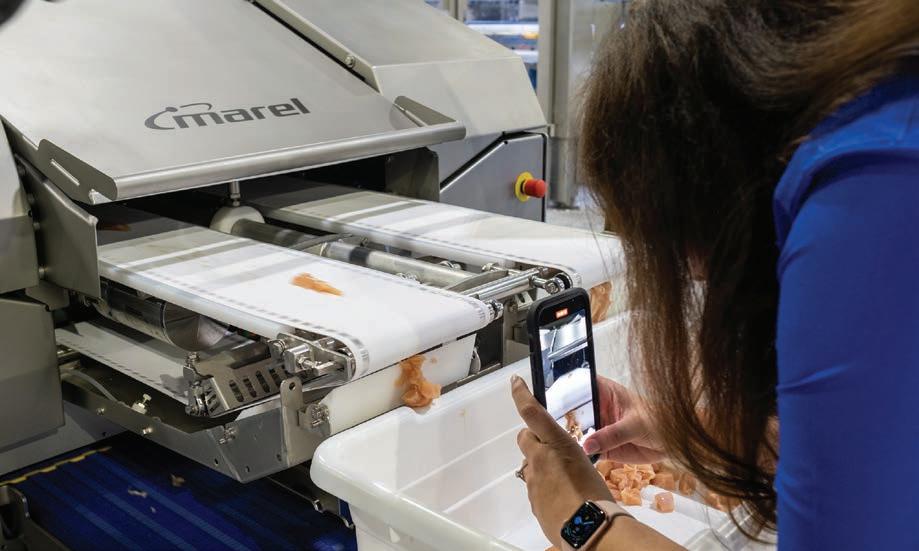
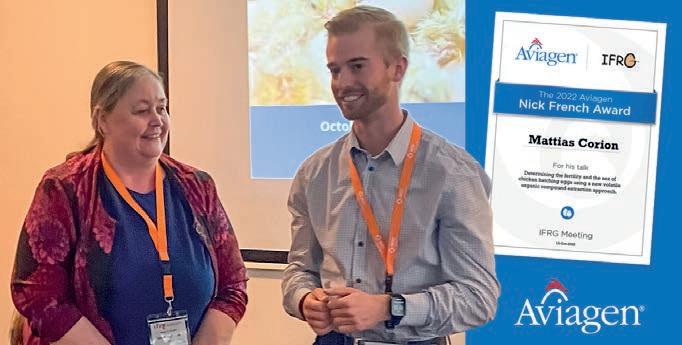
“I feel honored and humbled to accept the Nick French award for the second time,” remarked Matthias. “My aspiration is that my research will contribute to strengthening the ability of our industry to feed the world, while protecting animal welfare and the environment.”
Ampai Nangsuay, President IFRG, concluded: “We are proud of Matthias and impressed with the depth of his research and its potential to greatly benefit the industry. The WPSA shares with Aviagen a dedication to research that promotes the industry’s mission to help end hunger and advance the health and wellbeing of people around the world. This award plays a role in that mission by encouraging bright young scientists with passion and vision.”
IPPE CREATES NEW EXPERIENCES



























- december 2022 - 11 COMPANY NEWS
IPPE IPPE
Dinah Nicholson (left) congratulates 2022 Nick French award winner
IPPE IPPE
JAN. 24 - 26, 2023 ATLANTA, GA USA ippexpo.org
Let the 2023 IPPE create new experiences for you with thousands of animal food, meat and poultry industry professionals. Don’t miss your opportunity to connect at this powerhouse of a show in January!
Roxell introduces a new automatic nest: the Shenandoah® group nest
Roxell introduces the Shenandoah® group nest for broiler breeders. The Shenandoah experts - known for the popular individual nest - designed this innovative group nest concept.
and natural behavior. This results in fewer out-of-nest eggs and a surplus of nest eggs with a higher average per hen.
Higher fertility rates
The following features are aimed at ensuring high standards of nest hygiene for a successful, antibiotic-free production house:
More nest space and increased profitability with the solid Shenandoah ® reputation
Specific features ensure: a higher nest acceptance; good hygiene for the chicken and egg; careful handling of a large volume of eggs.
Due to the efficient design of the nest width and depth, this nest can increase the capacity and profitability of broiler breeders houses. Switching from an individual nest to an automatic group nest is easy because no changes need to be made to the layout of the house. The management is exactly the same as well. By offering more usable nest space, Shenandoah continues to support the growth ambitions of poultry farmers.
Good nest acceptance results in more nest eggs
At the core of the Shenandoah group nest is the provision of sufficient space and oxygen. Since chicken breeds are larger these days, spacious, oxygen-rich compartments are essential. That is why the nest has the largest and deepest nest boxes for houses with a ‘US-style’ layout. The ventilation in the nest is guaranteed with the perforated AstroTurf nest mat. To simulate a natural living environment, the nest opening has a step and short curtains. For the hen, it’s an entrance to a safe space with lots of shade. The Shenandoah group nest creates the right balance between space, oxygen, ventilation, hygiene
• Every evening an automatic expulsion system (with a bar) gently pushes the hens out of the nest, so they cannot brood overnight or remain in the nest. This is a very animalfriendly method that is unique in the sector.

• Inside the nest, the AstroTurf mat carries away waste to maintain a high level of hygiene.
• With the large perforations in the egg belt, waste can simply drop through. The egg belt is made of polyester with a layer of plastic on the outside to prevent stretching.
As well as hygiene, another factor that influences the fertility rate is the way the eggs are handled. Nest mats prevent hairline cracks from forming and there are streamlined transitions during the transport to the egg collection table. To accommodate the extra volume of eggs, the egg belt is adapted to large capacities.
12 - company newsCOMPANY NEWS
30 extra hens per nest box in an existing house
With this group nest, it is easy to increase the stocking density in an existing broiler breeder house. The Shenandoah group nest is just as long as the individual nest, i.e. 8 ft (2.4 m). The difference is in the group compartments, which have been laid out more efficiently. They are wider, deeper and have a fully flat nest floor. This increases the usable nest space by 50%, which means the average capacity per nest box increases by 30 hens.
Small step: from individual to group with the same house layout
Broiler breeders are becoming larger. Due to the growing size of the birds, it’s only a matter of time before group nests will be a necessity. Shenandoah makes it easy to transition from an individual nest to a group nest. No changes need to be made to the general layout of the house. With this group nest,
a poultry farmer can expand their nest space without needing to make adjustments to the existing systems. The management of the house also remains the same as usual.

“We took great care in developing this Shenandoah group nest”, said Frank Hartmann, Marketing Manager at Roxell
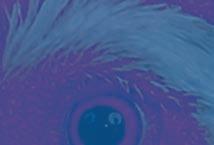

“This group nest was to become the solution for poultry farmers with larger breeds that want to increase their stocking densities without hefty investments. We also needed to make sure the new nest meets the applicable regulations. However, we were able to make it happen. By changing the nest layout and expanding the nest volume, we created 50 % more space. This is a luxurious amount of space for a nest. We extensively tested the hens’ responses to the new concept, as always. First with a live set-up at the Roxell test center, and then in the test houses in the USA and later at the Cobb breeding company.”
First choice in agricultural ventilation components



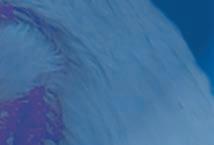




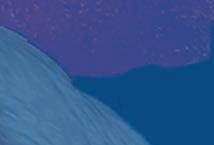


- december 2022 - 13 COMPANY NEWS
tpi-polytechniek.com tpi-polytechniek.com | The Netherlands
Peter R. Ferket Ph.D.
William Neal Reynold’s Distinguished Professor of Poultry Science, Nutrition, and Biotechnology
Prestage Department of Poultry Science, North Carolina State University. Raleigh, NC 27695
An ecological approach to manage gut health in turkeys

Gut health has a great influence on the growth performance and welfare of turkeys, as it affects feed digestion, nutrient absorption, protein and energy utilization, immunity and disease resistance, metabolism, and physiology. Genetic selection for faster growth along with public pressure to eliminate antibiotic growth promoters in the production of meat products has made gut health a priority concern for the turkey industry.
Introduction
Gut health has a great influence on the growth performance and welfare of turkeys, as it affects feed digestion, nutrient absorption, protein and energy utilization, immunity and disease
14
DOSSIER - dossier -
resistance, metabolism, and physiology. Indeed, gut health may be of greatest concern among turkey producers because of its impact on economic sustainability, and their customers’ concern about food safety and traceability. Gut health and nutrition are intricately dependent upon one another. Optimum dietary nutrient utilization cannot be realized unless the gut is in a healthy state. Traditionally, intestinal health has been largely dependent on prophylactic and therapeutic uses of antibiotics. According to the Center of Disease Dynamics, Economics and Policy (https://cddep.org), “more antibiotics are used in poultry, swine, and cattle to promote growth and prevent disease than are used by the entire human population. Global use of antibiotics in animals are expected to increase between 2010 and 2030 in countries such as China, Brazil, India, and Russia. However, the voluntary or legislated limits on the use of antibacterial feed additives for poultry are requiring changes in the methods to maintain good intestinal health. Today, the focus needs to be on earlier establishment of immunity and intestinal integrity if birds are to reach their maximum potential for growth and feed efficiency. In modern turkeys, attention to the first weeks of life is critical to achieve the best possible performance later. High quality nutrients provided early in life are needed to ensure the development of immunity, microbial intestinal maturity and proper tissue building in the intestinal tract. Therefore, understanding the role of feed formulation to optimize gut development and health is vital for achieving future sustainability and for improving the efficiency and environmental acceptability of poultry production. The objective of this paper is to review nutritional strategies to optimize gut development and health and control pathogen colonization with emphasis on potential natural alternatives to antibiotics.
The microbial ecosystem of the avian gut
Finding alternatives to antibiotics to control gut health can be more easily understood if one considers it from an ecological perspective. It has much to do with maintaining a stable ecosystem in the hindgut for symbiotic bacteria to flourish rather than allow conditions that favor the proliferation of pathogenic or competitive microbes. Birds can harbor an extensive and diverse microflora throughout the digestive tract, but they are mainly hindgut fermenters, accommodating large numbers of different microbes in the ceca. The microorganisms in the
intestinal tract become attached to mucosal surfaces or food particles, or they remain free-living in the lumen. Micro-communities in different parts of the tract develop only after the successive establishment of some types of organisms and a decline of others, which characterize symbioses. In poultry, bacterial populations resembling those of adult small intestine are present within two weeks of hatching, but it takes 30 or more days in the ceca to develop a stable and dynamic population. The slow rate of development appears to be due to the highly sanitized hatching and rearing conditions, the lack of contact with the mother hen, and the use of antimicrobial feed additives commonly used in commercial poultry production.
Factors that affect ecosystem structure and function
Whether an ecosystem is as robust as the Amazonian jungle or as fragile as the far northern tundra, the three factors that influence ecological structure and function most are:
• the ecological environment;
• nutrient balance;
• symbiotic flora stability.
Likewise, these three general factors are important to any farmer who wishes to yield a bountiful crop; he must cultivate the land and plant good seed (prepare the ecological structure), feed the crop a good balance of nutrients at agronomic rates (nutrient balance), and maintain the crop free of weeds and pests (symbiotic flora stability). Managing the enteric ecosystem is a similar process to yield a good crop of chickens.
Develop a robust ecological environment (cultivate and seed the gut ecosystem)
Developing a robust ecological environment in the gut is paramount to establishing lasting gut health and nutrient utilization efficiency. Conditioning the ecological environment that supports a healthy gut depends on early development and digestive function, colonization of symbiotic microbiota that will resist the colonization of pathogens, and physical structure of the diet to stimulate “normal” gut motility that helps maintain the distinct microenvironments through the length of the intestinal tract.
15 - december 2022DOSSIER
Establishing a robust enteric ecosystem all begins by appropriate adaptive conditioning during the perinatal period: the first 3 days before and 3 days after hatch. Incubation distress (excessive temperature and low oxygen) due to improper ventilation and air exchange adversely affects enteric development. In contrast, we (Uni and Ferket) have demonstrated that supplementing the perinatal chick’s first meal (the amnion) by in ovo feeding greatly advances gut development, skeletal health, immune function, meat yield, and growth performance efficiency.
The benefits of in ovo feeding on early growth and development of broilers and turkeys have been demonstrated by several experiments in our laboratory. In ovo feeding (IOF) has increased hatchling weights by 3% to 7% (P<.05) over controls, and this advantage is often sustained at least until 14 days post-hatch. The degree of response to in ovo feeding may depend upon genetics, breeder hen age, egg size, and incubation conditions (i.e. the epigenotype). Above all, IOF solution formulation has the most profound effect on the neonate. The positive effects of IOF has been well documented in a review by Peebles (2018). IOF clearly advances the digestive ca-

pacity, energy status, and development of critical tissues of the neonate by about 2 days at the time of hatch. Using scanning electron microscopy, Bohórquez et al. (2008) observed that IOF significantly increased functional maturity and mucus secretion of goblet cells of villi of ileum and ceca of turkey poults. Associated with these goblet cells was the colonization of lactobacilli. Therefore, IOF may help improve the colonization resistance of enteric pathogens of neonatal chicks and poults. Based on the rapidly growing number of peer-reviewed publications from around the world, IOF consistently shows promising benefits, especially if applications can be done without compromising hatchability.
Probiotics
A probiotic (direct-fed microbial) is defined as “a live microbial feed supplement that beneficially affects the host animal by improving its intestinal microbial balance”. In a sense, probiotic application “seeds” the microflora with beneficial organisms that promote a symbiotic enteric ecosystem. Lactobacillus and Bifidobacterium species have been used most extensively in humans, whereas species of Bacillus, Enterococcus, and Saccharomyces yeast have been the most common organisms used in livestock.
More recently, Clostridium buytricum has been shown to be a particularly effective probiotic for poultry post-hatch and by in ovo application. These symbiotic microorganisms competitively exclude pathogenic microorganisms by the following possible mechanisms: 1) lowering the pH through production of fermentation acids; 2) competing for mucosal attachment and available nutrients; 3) producing bacteriocins; 4) stimulating the gut associated immune system through cell wall components; and 5) increasing the production of short-chain fatty acids, which have bacteriostatic and bactericidal properties and stimulate intraepithelial lymphocytes, and natural killer cells. In a study that challenged turkey poults with Salmonella spp., Rahimi et al. (2009) observed a probiotic supplement increased the barrier function of the enteric mucosa, such as increased mucin secretion and more organized villi morphology that support the concept of gut health and function.
Probiotics have some disadvantages in comparison to other modulators of enteric microflora. Relatively few species of microorganisms can be considered for use in probiotics products due to their limited knowledge of
16 DOSSIER - dossier -
cultivability and required conditions for application and storage, such as extreme anaerobiosis. Probiotics have a short shelf-life and most are labile to excessive heat and pressure during feed processing. Some probiotic microorganisms may be reduced or eliminated by the low pH in the gizzard, and thus have little effect in the lower intestinal tract where pathogens pose problems. If a probiotic is added to the drinking water, the chlorine sanitizer may adversely affect its survivability. Acidification would be a better sanitizer than chlorine when delivering a probiotic via the drinking water.
Particle grind size of feed important to establish health gut motility
Good gut motility is necessary for proper food diges
particle size, and particle integrity) are important for proper gizzard musculature and motility. The gizzard is the “pace-maker” of normal gut motility in birds. Unlike mammals, vigorous gut refluxes (reverse peristalsis) are normal in birds as an adaptation to compensate for a short intestine. The refluxes serve to re-expose intestinal digesta to gastric secretions, vigorously mix digesta with enzymes to enhance digestion, enhance nutrient absorption over a short segment of the gut, and discourage microbial proliferation that may cause disease or compete for nutrients. Enteric disorders, such as diarrhea, swollen proventriculus, and gizzard erosion may be partially a consequence of dysfunctional gut motility associated with processed feed characteristics. The primary objective of modern feed manufacturing (grinding, post-mix grinding, steam conditioning, expansion, and pelletizing) is to reduce the bird’s “work” of feed prehension and enhance digestion for the sake of maximizing feed conversion efficiency. Although all this mechanical work invested into

17 - december 2022DOSSIER
Barbieri srl Via Garibaldi, 54 • 26040 Scandolara Ravara (CR) Italy Tel. (+39) 0375 / 95135 • Fax (+39) 0375 / 95169 • Manu re re moval belt s • Manu re belt wi th hole s for dr yi ng system s info@barbieri-belts.com www.barbieribelts.com BELTS and ROP ES for AV ICULTURAL USE BE LT S
processing feed reduces the work load of the gizzard to grind the ingested food, it also leads to atrophy and malfunction of the gizzard and associated gut motility. Poor peptic digestion by pepsin in the gizzard will result in less efficient peptic digestion by trypsin and chymotrypsin in the duodenum. Consequently, more undigested proteins end up in the hindgut where they are subject to microbial fermentation. Poor protein digestibility will cause an undesirable shift in the hindgut microflora towards proteolytic and pathogenic bacteria.
Managing nutrient balance of the enteric ecosystem (feed the symbionts; starve the pathogens)
Dietary enzyme supplementation has become a standard practice in the poultry industry, largely driving by the rising feed ingredient costs, particularly sources of dietary phosphorus, energy, and protein. Increasing use of grain and oilseed processing co-products that have lower nutrient digestibility has also created greater incentives for use of supplemental enzymes, especially in feeds that are not supplemented with pharmaceutical antimicrobial feed additives. Supplemental enzymes in the feed are used to achieve one or all the following objectives:
a) increase the animal’s own supply;
b) alleviate the adverse effects of antinutritional factors, such as arabinoxylans, b-glucans, etc;
c) render certain nutrients more available for absorption and enhance the energy value of feed ingredients, and
d) modulate intestinal microflora to a healthier state.
The major enzymes used in animal feeds are hydrolytic protease, amylase, lipase, phytase, NSP-degrading enzymes, and cellulase. Commercial enzymes products are typically a blend of several different enzymes that are effective on a wide variety of substrates. The enzymes with proven efficacies for animal husbandry include xylanase, arabinoxylanase, b-glucanase, cellulase, phytase, and mannanase. Amylase and lipase are enzymes commonly used in corn-SBM based diet to supplement endogenous enzymes of the animal, thus improving nutrient digestibility and growth performance characteristics. Phytate is a universally antinutrient present in all plant material that irreversibly chelates divalent cations and interferes with amino acid absorption in the gastrointestinal tract
of birds. Supplementation of poultry diets with enzyme mixtures, including proteases and amylases, has produced significant improvements in growth performance. Greenwood et al. (2002) reported that supplementing a corn-SBM broiler starter diet with an enzyme preparation containing a mixture of xylanase, protease, and amylase increased body weight at 14 and 42 days of age. The effect of exogenous xylanases in improving dietary nutrient availability is more complex than phytase. Endoxylanase degrades the xylan backbone of arabinoxylan into smaller units, which has several beneficial consequences. It renders the xylose units more available to monogastrics. It disrupts the water holding capacity of the NSP, and reduces the viscosity of the digesta in the small intestine. Reduced digesta viscosity increases the diffusion rates of nutrients and endogenous enzymes enabling the bird to digest and absorb more nutrients. Endoxylanase releases entrapped nutrients for the digestion by the endogenous enzymes of the bird. Endoxylanase inhibits the proliferation of the fermentative microorganisms in the small intestine by increasing the digesta passage rate and nutrient digestion. Thus, nutrient utilization is improved by reducing the competition between the host and its enteric microflora.
Many authors have shown the interaction between pentosans, microflora, and enzyme supplementation. Fischer and Classen (2000) reported that bacterial count from the small intestine of broilers fed wheat- based diets was lower in xylanase-supplemented birds than the unsupplemented ones. Because enzymes supplementation reduces the microbial population in the small intestine, the entire intestinal ecosystem can change. These conditions in the intestine alter the composition and activity of intestinal microflora. When the microflora profile changes after enzyme supplementation, there is a decrease in the adverse effects of microbial fermentation. Some of the adverse effects of active microbial fermentation include: deconjugation of bile salts reducing fat digestion; competition between the host and the microflora for nutrients; atrophy of the intestinal villi and enlargement of digestive organs. Additionally, Santos (2006) showed that dietary supplementation of NSP-degrading enzymes (endoxylanase and complementary enzymes blends) reduces the adverse effects of dietary NSP on nutrient digestibility, and increases the variety of non-starch oligosaccharides that serve as substrate for a more diverse microflora, thus augmenting the positive effect of NSP on ecosystem stability and discouraging Salmonella colonization in turkeys.
18 DOSSIER - dossier -
Maintaining a symbiotic enteric microbiome
Several strategies have been proposed as a means to manage intestinal microflora and gut health through diet formulation. Growth-promoting antibiotics (AGP) work in part by decreasing the microbial load in the intestinal tract, resulting in a reduction in energy and protein required to maintain and nourish the intestinal tissues; thus, more nutrients are partitioning toward growth and production. In contrast, most “natural” feed additives do not reduce overall microbial loads, but they alter the intestinal microflora profile by limiting the colonization of unfavor able bacteria and promote the activity or growth of more favorable species. AGP alternatives modulate gut health by several possible mechanisms: altering intestinal pH; maintaining protective intestinal mucins; selection for beneficial intestinal organisms or against pathogens; en hancing the fermentation volatile short-chain fatty acids; enhancing nutrient uptake; and increasing the humeral immune response. Although there is growing scientific support for many of these antibiotic replacements, the claim of efficacy is in many cases inadequately substan tiated. The search has been for a single intervention or product to replace antibiotics, and this has shown to be less efficient than a multi-factorial approach. A number of options are available for enhancing the performance of poultry in the absence of specific feed-additive antibi otics. However, an alternative strategy or program must yield comparable economic return, and production efficiency must be sustainable if it is to be accepted for commercial use.
Herbs, spices and essential oils have been used to make human foods more appetizing for centuries, and many of them are recognized for their health benefits. Essential oils have long been recognized for their anti-microbial activity (Lee et al., 2004a), and they have gained much attention for their potential as alternatives to antibiotics. Lee and Ahn (1998) found that cinnamaldehyde, derived from the cinnamon essential oil, strongly inhibit Clostridium perfringens and Bacteroides fragilis in vitro, and moderately inhibit Bifidobacterium longum and Lactobacillus acidophilus isolated from human. Also, a wide range of in-vitro anti-microbial activities of essential oils derived from cinnamon, thyme and oregano have been published. Although the exact anti-microbial mechanism of essential oils is poorly understood, it may be associated with their lipophilic property and chemical structure.
KEEP UP ON TRENDS AND CHALLENGES of poultry industry with
It’s been 50 years since Zootecnica International started serving the poultry industry and professionals. Today the magazine is edited in three languages (English, Italian and Russian) and delivered monthly in 120 countries, reaching around 30.000 readers all over the world.
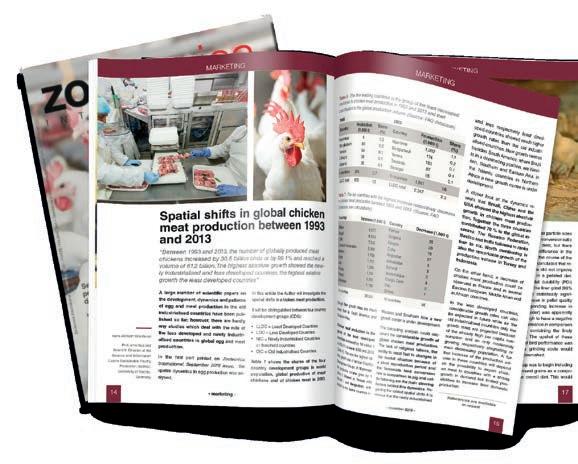
The target of Zootecnica International includes farmers, egg producers, breeding companies, hatcheries, feed mills, poultry and egg processing companies. Magazine and website offer a broad overview on the poultry industry, providing in-depth news on international markets, business management, trends and practices in poultry, genetics, incubation, nutrition, veterinary and management.
zootecnicainternational.com
19 - december 2022DOSSIER
Helander et al. (1998) investigated how two isomeric phenols, carvacrol and thymol, and the phenylpropanoid, cinnamaldehyde, exert their antibacterial effects on E. coli O157 and S. Typhimurium. Both carvacrol and thymol disintegrated the membrane of bacteria, leading to the release of membrane- associated materials from the cells to the external medium. Conversely, cinnamaldehyde exhibited its antibacterial activity due to its lipophilicity of terpenoids and phenylpropanoids, which can penetrate the membrane and reach the inner part of the cell and impair bacterial enzyme systems. Therefore, these plant- based phenolic compounds have antimicrobial effects similar to antibiotic compounds produced by fungi. As with antibiotics, continued use of these plantbased antimicrobials may result in the development of resistance in some pathogenic bacteria. However, more research is necessary to confirm this risk. To be as effective as growth promoters, these herbal antimicrobial compounds must be supplemented to the feed in a more concentrated form than found in their natural state, which will increase usage costs.
Acidifiers and organic acids have been used for decades in feed preservation, protecting feed from microbial and fungal destruction or to increase the preservation effect of fermented feeds (e.g. silages). Because organic acids have strong bacteriostatic effects, they have been used as Salmonella-control agents in feed and water supplies for livestock and poultry. The most common organic acids in animal nutrition are citric acid, propionic acid, fumaric acid, lactic acid, formic acid and benzoic acid. Additionally, some other available acidifiers and organic acids have been shown to have some antimicrobial activity. The antibacterial activity of organic acids is related to the reduction of pH, as well as their ability to dissociate and easily enter the microbial cell by both passive and carrier-mediated transport mechanisms. Once in the cell, the organic acid releases the proton H+ in the more alkaline environment, resulting in a decrease of intracellular pH. This hinders microbial metabolism by inhibiting the action of important microbial enzymes and forces the bacterial cell to use energy to export the excess of protons H+, ultimately resulting death by starvation. In the same matter, the protons H+ can denature bacterial acid sensitive proteins and DNA. Generally lactic acid bacteria are able to grow at relatively low pH, which means that they are more resistant to organic acids than more pathogenic species. Lactic acid bacteria, like other Gram-positive bacteria, have a high intracellular potassium concentration, which counteracts acid anions. The use of organic acids has not gained as much attention in poultry production, partly because limited positive responses in weight gain and FCR. However, Vogt et al. (1982) reported a positive influence on either FCR or growth performance by dietary supplementation of fumaric acid, propionic acid, sorbic acid and tartaric acid in broiler diets. Dietary supplementation of coated sodium butyrate was also found enhance growth performance of broilers, attributed to better mucosal development.
Mannan oligosaccharide (MOS) is derived from mannans on yeast cell surfaces and is not used as a substrate in microbial fermentation; but, it still exerts significant growth-promoting effect by enhancing the animal’s resistance to enteric pathogens. Based on the literature, MOS enhances an animal’s resistance to enteric disease and promotes growth by the following means: 1) inhibits colonization of enteric pathogens by blocking bacterial adhesion to gut lining; 2) enhances immunity; 3) modifies microflora fermentation to favor nutrient availability for the host; 4) enhances the brush border mucin barrier;
20 DOSSIER - dossier -
“A number of options are available for enhancing the performance of poultry in the absence of specific feedadditive antibiotics. However, an alternative strategy or program must yield comparable economic return, and production efficiency must be sustainable if it is to be accepted for commercial useˮ
and 5) reduces enterocyte turnover rate. MOS act as high affinity ligands, offering a competitive binding site for a certain class of bacteria. Gram-negative pathogens with the mannose-specific Type-1 fimbrae attach to the MOS instead of attaching to intestinal epithelial cells and they move through the gut without colonization. Spring et al. (2000) observed five of seven strains of E. coli and 7 of 10 strains of Salmonella typhimurium and S. enteritidis agglutinated MOS and Sac. cerevisiae cells. However, strains of S. choleraecuis, S. pullorum, and Campylobacter did not lead to agglutination. Although MOS does not bind clostridia, it does reduce clostridia numbers in some trials, possibly by enhancing the mucin barrier or stimulating gut-associated immunity.
Conclusion
Although AGP have served the poultry industry well in maintaining efficient production and animal welfare, the availability of this valuable production tool will become
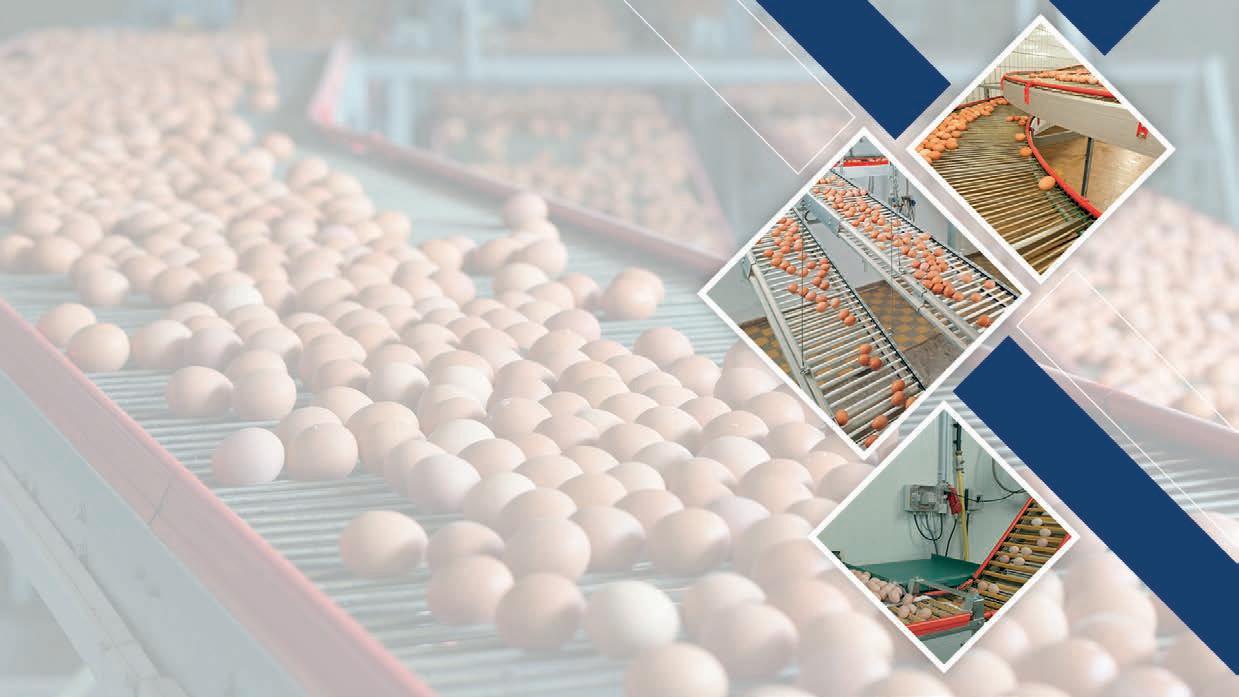
limited in the future because there will be no such products that will be developed in the future and use of remaining AGP will be constrained because of government regulations or consumer demands. Indeed, finding alternatives to AGP to maintain gut health and efficient growth performance in poultry is a priority. Strategic use of these alternatives is dependent upon understanding their modes of action and how they influence the dynamic enteric ecosystem. A stable enteric ecosystem, particularly in the hind gut of poultry, is essential as symbiotic microflora competitively excludes the adverse effects of more pathogenic species. Establishment of that stable ecosystem depends on uncompromised early gut development, gut motility conditioning by the structural properties of feed, and strategic use of organic acids, essential oils, prebiotics, probiotics, and enzymes.
References are available on request
From the Proceedings of the Midwest Poultry Federation Convention 2021
21 - december 2022DOSSIER
!lanigirO For further information, please visit www.lubingsystem.com Or send an e-mail to info@lubing.it
Dynamics and patterns of the poultry industry in the G19 countries between 2010 and 2020
Part 1 – Poultry meat production
The G20 (Group of Twenty) was founded in 1999 in Berlin as a forum of 19 individual member countries and the EU1. It substituted the former G8 group. The main goal of the forum is to undertake means, which contributes to the stability of the global financial situation. The heads of the G20 countries hold annual summits to discuss financial and trade matters. Conferences of the finance and foreign ministers hold separate meetings. The composition of the group has been criticized frequently in the past. In this report, 19 instead of 20 countries will be analysed. The EU was omitted as four member countries are among the G19.
at country level, dynamics and changes in the spatial patterns of production will be documented in a first paper. A second paper will deal with the dynamics and patterns of poultry meat trade.
 Hans-Wilhelm Windhorst
Hans-Wilhelm Windhorst
The author is Prof. Emeritus of the University of Vechta and visiting Professor at the Hannover Veterinary University, Germany
The role of the G19 in a global setting
In 2020, the G19 countries shared 58.2% of the global population, 83.0% of the GDP, contributed 65.1% to global poultry slaughter and shared 70.8% in global poultry meat production (Table 1). In a detailed analysis
Fast increase of poultry meat slaughter
Global poultry meat slaughter increased by 14.6 billion head between 2010 and 2020 or 24.0% and reached a volume of 75.2 billion head. The data in Table 2 shows that only turkey slaughter decreased in the analysed decade. Chicken slaughter dominated with a share of 94.1% in 2020 and contributed 97.1% to the growth since 2010. The highest absolute growth of the slaughter volume
22 MARKETING - marketing -
1 Member countries are Argentina, Australia, Brazil, Canada, China, France, Germany, India, Indonesia, Italy, Japan, the Republic of Korea, Mexico, the Russian Federation, Saudi Arabia, South Africa, Turkey, the United Kingdom, the United States and the European Union.
Parameter Share (%) at global level Population GDP Poultry slaughter Poultry meat production Chicken meat production Turkey meat production 58.2 83.0 65.1 70.8 69.3 79.1
Table 1 – The role of the G19 countries in a global setting (2020) (source: FAO database, World Bank; own calculations).
showed Indonesia with 2.7 billion head, followed by Brazil (1.0 billion), China (858 mill.), Russia (841 mill.) and India (809 mill.). The highest relative increase showed Indonesia with 140.8%, followed by Russia (50.8%), Korea, Rep. (45.2%), India (44.5%) and Australia (28.5%). The five countries with the highest absolute growth contributed 74.7% to the increase of the G19 slaughter volume and 44.4% to the global growth.
Remarkable growth of poultry meat production
Poultry meat was the fastest growing of all animal products in the analysed time-period. The favourable feed-conversion and the lack of religious barriers regarding consumption made poultry meat the most attractive protein source beside eggs and milk.
Figure 1 documents the changing shares of the meat types in poultry meat production at G19 and global levels between 2010 and 2020. It is worth noting that at both regional levels the share of chicken meat increased while that of the other three meat types decreased. Turkey meat lost 1.1% at the global level and even 1.9% at the G19 level.
Between 2010 and 2020, global poultry meat production increased from 99.2 mill. t to 133.3 mill. t or by 34.3%. In the G19 countries, the production volume grew from 71.7 mill. t to 94.3 mill. t or 31.5%. To the global growth of 34.1 mill. t, the G19 countries contributed 22.6 mill. t or 66.2%. This data documents the extraordinary role of the G19 countries in the dynamics of the global poultry meat industry. A closer look at the ranking and shares of the G19 countries reveals some remarkable changes (Table 3). USA, China and Brazil kept the three leading po -
sitions although they lost shares in the global production volume. This is a result of the fast increase of production in Russia, Indonesia and India.
Russia and Indonesia gained higher rankings while Mexico lost two places and India one place. In five of the G19 countries, the production volume grew by more than 2 mill. t each. Table 4 documents the remarkable growth of their production between 2010 and 2020. France was the only country with a decrease in poultry meat production.
A comparison of the dynamics of poultry meat types at the global and G19 level between 2010 and 2020 reveals (Table 5) that the production increased faster at the global level. Worth noting is in particular that turkey meat production in the G19 countries grew much slower with only 1.6%. The analysis at country level for the four meat types will document the differences and similarities in the dynamics.
23 - december 2022MARKETING
2.2% 3.7% 4.5% 89.6% Chicken Turkey Duck Goose* 2.5% 4.1% 5.6% 87.8% World Total: 99.2 mill. t 2010 Total: 133.3 mill. t 2020 * includes guinea fowl Chicken Turkey Duck Goose* G19 Total: 71.7 mill. t 2010 Total: 94.3 mill. t 2020 * includes guinea fowl 3.2% 4.6% 6.5% 85.7% 3.0% 4.4% 4.6% 88.0%
Figure 1 – The share of poultry meat types in global and G19 poultry meat production in 2010 and 2020 (design: A.S. Kauer based on FAO data).
Species 2010 2020 Mill. head Share (%) Mill. head Share (%) Chicken Duck Goose* Turkey Others 56,624 2,684 634 632 60 93.4 4.4 1.0 1.0 0.1 70,768 3,022 742 618 53 94.1 4.0 1.0 0.8 0.1 Total 60,634 100.0 75,203 100.0
Table 2 – The development of global poultry slaughter between 2010 and 2020 (source: FAO database).
*includes guinea fowl
High regional concentration in chicken meat production
Chicken meat contributed almost 90% to global poultry meat production and 88% to that of the G19 countries. Figure 2 shows the high regional concentration. In 2020, the three leading countries contributed
62.0% to the production volume of the G19 countries, the ten leading countries 69.4% (Table 6). Their share was, however, 1.1% lower than in 2010, which indicates that also in other countries chicken meat production grew considerably.
The remarkable dynamics was mainly a result of the fast increase in
the five leading countries (Table 7 ). Between 2010 and 2020, they contributed 67.0% to the growth in the group of the G19 and 44.4% to the global increase. Beside Indonesia and Russia, Korea, Rep., Japan and India also showed high relative growth rates. This confirms the growing importance of Asian countries in the dynamics of global chicken meat production. The relative growth rate of the G19 countries was lower than that at the global level. This indicates the fast growth of production also in countries not belonging to the group of the G19.
Stagnation in turkey meat production
In 2020, only 12 of the G19 countries produced turkey meat. In contrast to the global development, their production increased by only 75,000 t or 1.6%. Table 8 shows the ten leading G19 countries in 2010 and 2020.
* sum does not add because of rounding
Table 4 – The growth of poultry meat production in the five G19 countries with the highest absolute increase between 2010 and 2020 (source: FAO database; own calculations).
A comparison of the ranking and the share reveals that the contribution of the ten leading countries to the global production volume fell by 5.4%. A closer look at the changes at country level shows that in six of the twelve producing countries production decreased, in France by 84,000 t, by 19,000 t in the United Kingdom and by more than 3,500 t each in Mexico and Australia. A considerable growth occurred in Brazil with 99,000 t, the USA (47,200 t), Turkey (26,000 t) and Italy (15,000 t). The other countries showed only minor differences. Steering factors behind the differences in the dynamics were changes in the per capita consumption, impacts of Avian Influenza outbreaks and related banning of exports.
24 MARKETING - marketing -
2010 2020 Country Production (1,000 t) Share (%) Country Production (1,000 t) Share (%) USA China Brazil Mexico Russia India France Argentina Un. Kingdom Indonesia Turkey S. Africa Japan Germany Canada Italy Australia Korea, Rep. S. Arabia 19,583 16,561 11,185 2,723 2,563 2,226 1,757 1,643 1,570 1,566 1,479 1,478 1,417 1,370 1,218 1,168 973 653 576 19.7 16.7 11.3 2.7 2.6 2.2 1.8 1.7 1.6 1.6 1.5 1.5 1.4 1.4 1.2 1.2 1.0 0.7 0.6 USA China Brazil Russia Indonesia Mexico India Japan Argentina Turkey Un. Kingdom S. Africa France Germany Canada Italy Australia Korea, Rep. S. Arabia 23,150 21,278 14,379 4,579 3,752 3,617 3,597 2,348 2,265 2,201 1,952 1,881 1,645 1,572 1,473 1,382 1,282 1,047 901 17.4 16.0 10.8 3.4 2.8 2.8 2.7 1.8 1.7 1.7 1.5 1.4 1.2 1.2 1.1 1.0 1.0 0.8 0.7 G19 71,70 9 *72. 4 G19 94,301 *70.8 World 99,270 100.0 World 133,357 100.0
Table 3 – The development of poultry meat production in the G19 countries between 2010 and 2020 (source: FAO database).
Country Absolute increase (1,000 t) Relative increase (%) China USA Brazil Russia Indonesia 4,717 3,567 3,194 2,014 2,006 28.5 18.2 28.6 78.6 139.6 5 countries 15,498 30.5 G19 countries 22,577 31.5 World 34,087 34.4
Remarkable growth of duck meat production
Between 2010 and 2020, global duck meat production increased by 919,000 t or 22.5%, in the G19 countries 704,000 t or 21.6%. In 2020, 15 of the G19 countries produced duck meat, contributing 79.4% to the global production volume.
A comparison of the ranking and share of the ten leading countries (Table 9) documents the dominating role of Asian countries. China, Korea, Rep., India and Indonesia increased their production and their shares. China alone contributed 85% to the global growth. The per capita consumption was much higher than in the other G19 countries with the exception of France. In contrast, duck meat production decreased by 90,000 t in France and 35,000 t in Germany. While massive Avian Influenza outbreaks caused the decline in the Southwest of France, changes in the legal regulations for keeping ducks and a declining per capita consumption led to a sharp decrease of the flocks and of duck slaughter in Germany. France mainly produced foie gras beside duck meat. It contributed about 75% to the global foie gras production. Because of the special form of production (gavage), several countries prohibited the marketing of this product. While duck meat consumption increased in Asia, it decreased or stagnated in the other G19 countries.
Extremely high regional concentration in goose meat production
Only ten of the G19 countries produced goose meat. East Asian and
some African countries dominated the production. Between 2010 and 2020, the global production volume increased from 2.4 mill. t to 2.8 mill. t or by 16.5%. The G19 countries shared 95.4%, China alone 95.1% (Table 10). Goose meat consumption outside China was very low and in most countries concentrated in a short period around Christmas.
Eagle Trax™
The intelligent hatchery software that turns data into maximum poultry performance
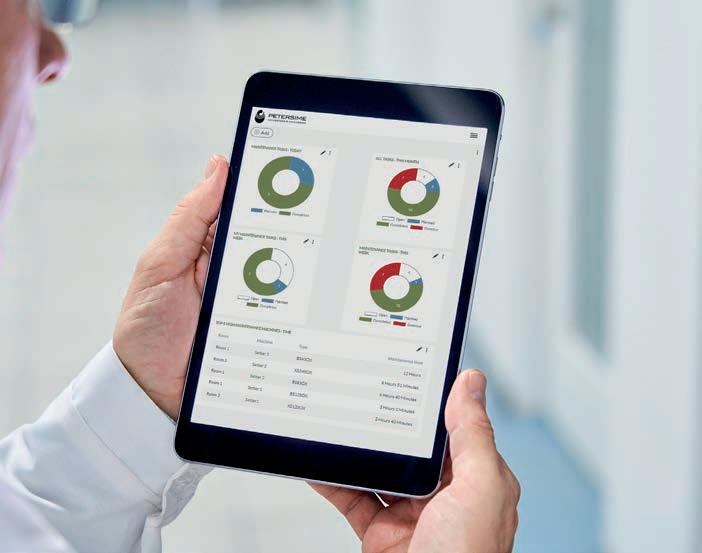
Hatcheries have a wealth of valuable data available. Unlocking the potential of that data presents a major opportunity to improve the overall performance of hatcheries as well as of the entire value chain. With Eagle Trax™, Petersime offers the first intelligent hatchery software that turns data into maximum poultry performance. Eagle Trax™ allows you to digitise, analyse and optimally use data to advance ever more in hatchery efficiency, productivity and chick quality.
With Eagle Trax™, your hatchery will always maximise the genetic potential of each hatching egg and deliver predictable output of the most profitable day-old chicks for everybody involved in the poultry value chain.
Scan for more information:
Let’s keep in touch!
www.petersime.com
25 - december 2022MARKETING
© Petersime 2022All rights reserved.
Summary and perspectives
The paper showed the fast growth of poultry meat production during the past decade. The production volume increased by 34.3% and reached a volume of 133.3 mill. t. The G19 countries contributed 67.0%. Chicken meat was the dominating meat type with a share of 88.0% in the G19 poultry meat production. The regional concen-
Table 6 – The development of chicken meat production in the G19 countries between 2010 and 2020 (source: FAO database).
* sum does not add because of rounding
Table 7 – The growth of chicken meat production in the five G19 countries with the highest absolute increase between 2010 and 2020 (source: FAO database; own calculations).
tration of production was very high. The USA, China and Brazil contributed 41.3% to the global production volume, the ten leading countries 69.3%.Their share however decreased by 1.2% since 2010, indicating a fast growth also in non-G19 countries. Turkey meat production seems to have reached a plateau in the G19 group, as the volume grew by only 1.6%. They lost 5.4% in their global share since 2010. Duck meat was dominated by Asian countries. In European countries, production decreased because of legal regulations in Germany, Avian Influenza
26 MARKETING - marketing -
Meat type G19 World Absolute (1,000 t) Relative (%) Absolute (1,000 t) Relative (%) Chicken Turkey Duck Goose* 21,420 75 704 378 30.0 1.6 21.6 16.2 32,295 476 919 403 37.0 8.6 22.5 16.5 Total 22,577 31.5 34,0 93 34.4
Table 5 – The development of global poultry meat production between 2010 and 2020 by meat types (source: FAO database).
*includes guinea fowl
2010 Total: 87.2 mill. t World Total: 61.5 mill. t G19 39.4% 1.7% 1.7% 1.8% 1.8% 2.5% 2.9% 3.1% 12,3% 13.3% USA China Brazil Mexico Russia India Argent. Indones. S. Africa Turkey Others 17.1% 2.3% 2.4% 2.5% 2.6% 3.6% 4.2% 4.4% 14.4% 18.9% 27.6% 2020 Total: 119.5 mill. t World Total: 79.9 mill. t G19 USA China Brazil Russia Indones. Mexico India Japan Argentin. Turkey Others 40.1% 1.8% 1.9% 2.0% 3.0% 3.0% 3.1% 3.8% 11.5% 12.7% 17.1% 10.4% 2.7% 2.8% 2.9% 4.4% 4.5% 4.6% 5.7% 17.3% 19.0% 25.7%
Figure 2 – The share of the ten leading G19 countries in global and G19 chicken meat production in 2010 and 2020 (design: A.S. Kauer based on FAO data).
2010 2020 Country Production (1,000 t) Share (%) Country Production (1,000 t) Share (%) USA China Brazil Mexico Russia India Argentina Indonesia S. Africa Turkey Japan U.K. France Canada Australia Italy Germany Korea, Rep. S. Arabia 16,971 11,592 10,693 2,681 2,563 2,193 1,598 1,540 1,472 1,444 1,417 1,376 1,064 1,051 934 865 337 588 575 19.5 13.3 12.3 3.1 2.9 2.5 1.8 1.8 1.7 1.7 1.6 1.6 1.2 1.2 1.1 1.0 1.0 0.7 0.7 USA China Brazil Russia Indonesia Mexico India Japan Argentina Turkey S. Africa U.K. Canada Australia France Italy Germany Korea, Rep. S. Arabia 20,490 15,144 13,787 4,577 3,708 3,579 3,551 2,348 2,219 2,138 1,873 1,784 1,305 1,247 1,130 1,067 1,066 962 900 17.1 12.7 11.5 3.8 3.1 3.0 3.0 2.0 1.9 1.8 1.6 1.5 1.1 1.0 0.9 0.9 0.9 0.8 0.8 G19 6 0, 9 54 *70.5 G19 82,875 * 69.4 World 87,210 100.0 World 119,505 100.0
Country Absolute increase (1,000 t) Relative increase (%) China USA Brazil Indonesia Russia 3,552 3,519 3,095 2,168 2,014 30.6 20.7 28.9 140.8 78.6 5 countries 14,348 33.1 G19 countries 21,421 34.9 World 32,295 37.0
* sum does not add because of rounding
* sum does not add because of rounding
outbreaks in France and a decline of the per capita consumption. China dominated global goose meat production with a share of over 95% in 2020. In all other G19 countries, it was only of minor importance. It can be projected that in particular chicken meat production will further increase and that the present spatial pattern will remain stable.
Data source and suggestions for further reading
FAO database: http://www.fao.org/ faostat.
G20: https://en.wikipedia.org/wiki/ G20.
Windhorst, H.-W.: The Champions League of the chicken meat producing countries. In: Zootecnica International 42 (2020), no. 7/8, p. 22-26.
Windhorst, H.-W.: The contrasting world of poultry production. In: Fleischwirtschaft international (2020), no. 3., p. 8-10.
Windhorst, H.-W.: The forgotten world: the chicken meat industry in the least developed countries. In: Zootecnica International 43 (2021), no. 3, p. 28-32.
Windhorst, H.-W.: Patterns and dynamics of the EU poultry industry: a status report. Part 2 – Poultry meat production and egg trade. In: Zootecnica International 44 (2022), no. 1, p. 28-32.
Windhorst, H.-W.: The dynamics of the U.S. broiler industry. Part 2: US profits from the rising demand of white meat. In: Fleischwirtschaft international 2022, no. 2, p. 52-54.
Worldbank: https://data.worldbank. org.
27 - december 2022MARKETING
2010 2020 Country Production (1,000 t) Share (%) Country Production (1,000 t) Share (%) China France Germany Turkey U.K. 2,319 5 3 2 2 95.1 0.2 0.1 0.1 0.1 China Turkey U.K. Canada Argentina 2,703 4 2 < 1 < 1 95.1 0.1 0.1 < 0.1 < 0.1 5 countries 2,331 *95.6 5 countries 2,710 *95.4 G19 2,333 95.7 G19 2,711 95.4 World 2,439 100.0 World 2,842 100.0
Table 10 – The five leading G19 countries in goose meat production in 2010 and 2020 (source: FAO database).
2010 2020 Country Production (1,000 t) Share (%) Country Production (1,000 t) Share (%) USA Brazil Germany France Italy U.K. Canada Argentina Turkey Australia 2,560 485 478 405 298 162 158 36 32 22 46.4 8.8 8.7 7.3 5.4 2.9 2.9 0.7 0.6 0.4 USA Brazil Germany France Italy Canada U.K. Turkey Argentina Australia 2,607 584 476 321 313 158 143 58 36 19 43.5 9.7 7.9 5.4 5.2 2.6 2.4 1.0 0.6 0.3 10 countries 4,636 *84.0 10 countries 4,715 *78.6 G19 4,663 84.5 G19 4,738 79.1 World 5,517 100.0 World 5,993 100.0
Table 8 – The ten leading G19 countries in turkey meat production in 2010 and 2020 (source: FAO database).
2010 2020 Country Production Share (%) Country Production Share (%) China France Korea, Rep. Germany USA India U.K. Indonesia Mexico Australia 2,650 282 65 62 53 33 30 26 21 17 65.0 6.9 1.6 1.5 1.3 0.8 0.7 0.6 0.5 0.4 China France Korea, Rep. USA India Indonesia Germany U.K. Mexico Australia 3,431 192 85 52 47 44 27 22 21 18 68.6 3.8 1.7 1.7 0.9 0.9 0.5 0.4 0.4 0.4 10 countries 3,239 *79.4 10 countries 3,939 *78.8 G19 3,263 80.0 G19 3,967 79.4 World 4,079 100.0 World 4,998 100.0 * sum does not add because of rounding
Table 9 – The ten leading G19 countries in duck meat production in 2010 and 2020; data in 1,000 t (source: FAO database)
1 University of New England, Armidale, NSW, Australia, Chungbuk National University, Cheongju, South Korea
2 University of New England, Armidale, NSW, Australia
Chicken sexing through beak morphometry
Feather sexing is no longer available due to a shift from slow feathering to fast feathering parent stocks: therefore, other convenient ways for chick sexing are needed for research trials.
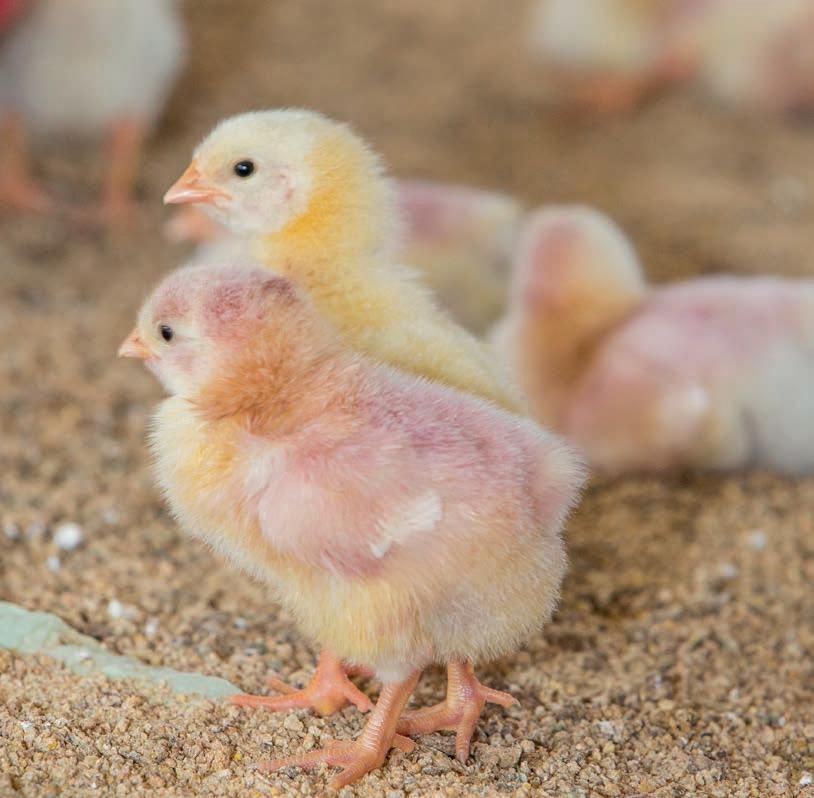
Feather sexing, a relatively convenient method to separate male and female dayold broiler chicks, is no longer available especially in Australia due to a shift from slow feathering to fast feathering parent stocks (England et al., 2021). Therefore, other convenient ways for chick sexing are needed for research trials. Vent sexing is a possibility, but the time required to successfully vent sex and biosecurity restrictions of hatcheries can make this difficult. Sex may also be determined with DNA analysis of feathers, but this can be time consuming and expen-
sive. Previous studies show that the beaks of some avian species such as finches (Herrel et al., 2010) and turkeys (Dalton et al., 2017) show sexual dimorphism. So, we hypothesized that beaks of day-old chicks may show sexual dimorphism as well.
To test our hypothesis in a pilot study, beaks of 64 chicks were photographed from the top and the right side for a comparison using landmark (LM) based geometric morphometry technique similar to Dalton et al. (2017). Based on vent sexing of the 64 chicks, 14
A. Iqbal1 and A. F. Moss2
28 - technical columnTECHNICAL COLUMN
were found to be males and 50 were found to be females. After discarding photos that did not meet the standards for analysis, 6 male side-view photos and 8 female side view photos were chosen. Similarly, 19 female top view photos and 5 male top view photos were selected.
The selected photos were used to identify several homologous morphological features as landmarks. These landmarks were digitised using TPSdig software and coordinate data of these landmarks were further processed and subjected to canonical variate analysis (CVA) in MorphoJ software to determine the statistical significance of differences between beak landmark configurations of male and female chicks.
The analysis calculated two types of distances between the landmark configurations, a Procrustes distance (PD) and a Mahalanobis distance (MD) as a measure of the difference between the landmark configurations generated from beak photos of male and female chickens along with their associated p-values to determine statistical significance. As the assumption of isotropic variation of landmarks that underlie the Procrustes method do not hold for most biological samples (Klingenberg, 2016), we used MD for this study.
Therefore, based on Mahalanobis distance, these results show significant (P=0.0005, MD=3.0746) difference in the top view landmark configurations between male and female day- old chicks beaks and a tendency (P=0.0583, MD=2.1014) towards significant difference using the side view configuration.
This was a pilot experiment and thus required larger sample sizes and optimisation of methods to capture photos of chicks. However, these results are promising and warrant further exploration into the potential use of beak images for sexing day old broiler chickens.
References
Dalton H.A., Wood B.J., Widowski T.M., Guerin M.T. & Torrey S. (2017). PloS One. 12: e0185159
England A.D., Kheravii S.K., Musigwa S., Kumar A., Daneshmand N., Sharma N.K., Gharib-Naseri K. & Wu S.B. (2021). Poult. Sci.100: 100924.
Herrel A., Soons J., Aerts P., Dirckx J., Boone M., Jacobs P., Adriaens D., Podos J. (2010). Emu - Austral Ornithology. 110: 39-47.
CARFED INTERNATIONAL LTD

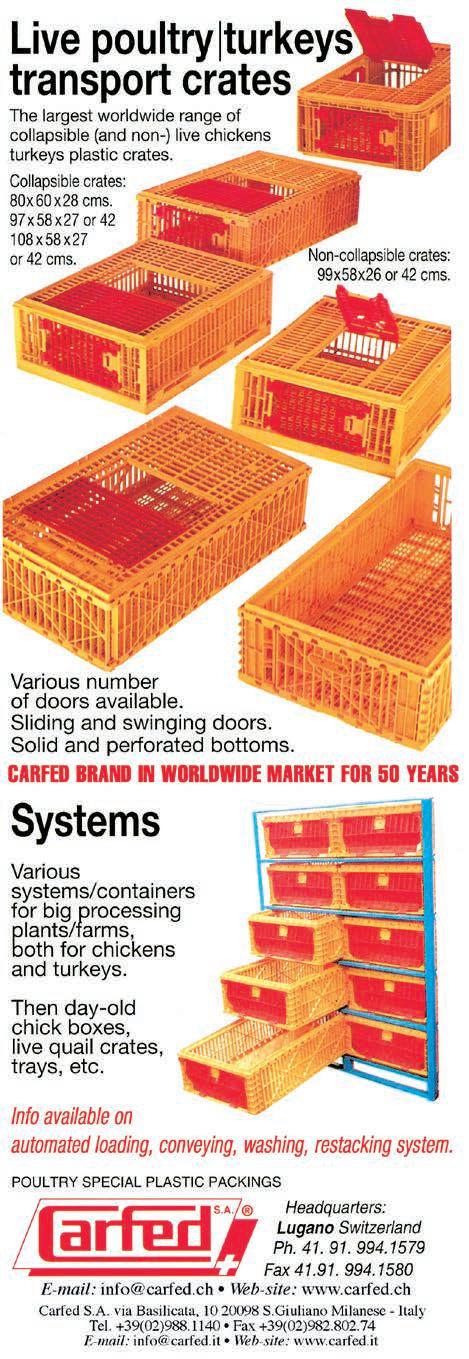
Italian headquarters: Piazza Oberdan 3, 20129 Milano (Italy)
Italian warehouse: Via Basilicata 10, 20098 San Giuliano Milanese (Italy)
Ph.: +39 02 9881140 – Fax: +39 02 98280274
Email: carfed@carfed.it – Website: www.carfed.it
29 - december 2022TECHNICAL COLUMN
headquarters: Ground
EC3V 9DF, England, UK Ph.: + 44. 20. 7660.0987 – Email: carfed@carfed.co.uk
UK
Floor, One George Yard, London
1 Animal Welfare Science Centre, Faculty of Veterinary and Agricultural Sciences, The University of Melbourne, Parkville 3010, Australia
2 University of New England, Faculty of Science, Agriculture, Business and Law, Armidale, NSW, 2351, Australia
Behaviour of pullets and housing system predicts behaviour of adult laying hens in commercial free-range egg farms

The relationship between behavioural responses of pullets during rearing and adult hens to both novelty and a human stimulus was explored using stepwise backward regression. The results indicate that the behavioural responses of pullets to both novelty and humans, and housing system in adulthood were predictive of the behavioural responses of hens to novelty and humans in adulthood.
Less fear of novelty during rearing and larger flock size in adulthood were associated with less fear of novelty or increased curiosity indoors in adulthood. Less fear of novelty during
30 MANAGEMENT - management -
M. Rice 1, R. Acharya1, J. Taylor1, P. Taylor 2, A. Fisher1 and P. Hemsworth1
©farmdrop.com
rearing and housing of laying hens in flat deck systems was associated with increased fear of novelty in adult laying hens in the range. In addition, less fear of humans in pullets during rearing, and subsequent housing in aviaries, was associated with less fear of humans in adult laying hens. Further exploration of these relationships could assist with the identification of risk factors for problem behaviour in commercial free-range laying hens.
Introduction
Early life experiences play an important role in the behavioural development of laying hens. Environmental differences in rearing systems have been shown to have an impact on behavioural problems such as feather pecking and cannibalism during adulthood. In addition, fearfulness early in life has been shown to correspond to increased stress response in adulthood. A greater understanding of the rearing conditions and their influence on hen behaviour during rearing and adulthood may assist in the prevention or mitigation of problem behaviours and therefore assist in the reduction of mortality and improvement of welfare in free-range laying hens.
This study examined the behavioural response of commercial free-range laying hens to humans and novelty during rearing and at peak lay. It was hypothesised that the behavioural response of pullets to humans and novelty would be predictive of their respective responses to humans and novelty, respectively, in adulthood.
Method
This study was approved by the Animal Ethics Committee of the University of Melbourne. Behaviour tests were conducted in-situ on 45 flocks (Hy-line brown, n=37; and ISA Brown, n=8) during rearing (15-16 wk old) and 39 adult flocks (45-55 wk old). Of the all the flocks tested, 26 flocks were tested at both rearing and in adulthood. Flocks were reared in either floor rearing (n=17) or JumpStart/Aviary systems (n=28). Adult flocks were housed in either flat deck systems (n= 20) or aviary systems (n=19) and had range access. Flock sizes ranged from 19,203 to 67,297 in rearing and 16,897 to 61,000 in adulthood.
The two behaviour tests were a flight distance test (FDT ) and a novel object test (NOT ) and bird responses were video recorded. The FDT involved an observer moving
through the shed (and range for adult flocks) in a standard manner stopping every 20 steps for 30 s. In the NOT a children’s toy was presented in three locations in the shed and range (for adult flocks). The number of hens within 1.5 m in front of the observer was recorded at every step when the observer was moving, and every 30 s whilst the observer was stationary in the FDT. The latency for hens to approach within 10 and 40 cm and interact with the novel object (NO), and the average number of hens within 40 cm of the NO were recorded every 30 s over 5 mins in the NOT.
A principal component analysis (PCA) with oblique rotation was performed in SPSS (version 27) separately on the two full sets of data from the behaviour tests conducted during rearing and with adult hens to identify sets of components that represent the underlying commonalities (components) in these tests and regression factor scores were calculated. Prior to analysis, all variables were transformed using inverse, log10 or square root transformations to normalise the data. Since the correlation coefficients were all above the required 0.3, the Kaiser-Meyer-Olkin (KMO) values exceeded the recommended value of 0.6, and Bartlett’s Test of Sphericity was statistically significant, the data were considered suitable for the PCA. A backwards stepwise regression was used to identify possible predictors of each of the component scores from the behaviour tests conducted in adulthood using data from the 26 flocks with both rearing and adult behaviour test data. At each step variables were removed based on p-values (P<0.1).
Results
Two components each with eigen values greater than 1 were extracted in the PCA for the tests during rearing, these were labelled RearFDT and RearNOT, and three components, all with eigen values greater than 1 were extracted in the PCA for the tests conducted on adult hens, these were labelled ProdFDT, IndoorNOT and RangeNOT (see Table 1 for component descriptions and loadings). In the resulting scores, a high score in both RearFDT and ProdFDT corresponds with more pullets/ hens within 1.25m of the human in both stationary and movement phases. A high score in both the RangeNOT and the IndoorNOT corresponds with less pullets/hens near the NO and longer latency to approach and interact.
The variables included in the original model and the final
31 - december 2022MANAGEMENT
Table 2 – Unstandardised coefficients and adjusted R2 for the initial and final regression model where RearFlockSize is the number of pullets (x 10,000), ProdFlockSize is the number of hens (x 10,000), RearShedType is the rearing housing system (Floor = 1, Aviary/JumpStart =2), ProdShedType is the adult hen housing system (Flat Deck = 1, Aviary = 2).
model of the regression are outlined in Table 2. Among the behaviour test variables from rearing, the NOT conducted during the rearing was predictive of the NOT conducted with adult hens both in the range and inside the shed; however this relationship was positive for the adult NOT tests conducted inside the shed, and negative for the NOT tests conducted in the range (i.e. flocks with a higher score in the NOT at rearing, are predicted to have a higher score in the NOT conducted in the shed and a lower score in the NOT conducted in the range during adulthood). The FDT in rearing remained in the final model predicting behaviour in the FDT for adult laying hens. Housing system for adult laying hens was predictive of both their response to the NOT in the range and during the FDT in adult flocks, with hens in aviary systems predicted to score lower in the NOT and higher in the FDT than hens in flat deck systems.
Discussion
It should be recognised that the two tests FDT and NOT were designed to measure the approach and avoidance responses of birds to humans and a novel object. Measures of exploration are often interpreted as providing information about fearfulness and are the basis of some of the standard tests of fear. Although it is unclear how exactly fear and exploration, particularly curiosity or inquisitive exploration, are related, it is generally agreed that high levels of fear inhibit all other motivational systems including exploration.
Several relationships were found in the present study between fear of humans and novelty (or conversely
32 MANAGEMENT - management -
Rearing test PCA Adult test PCA RearNOT RearFDT IndoorNOT RangeNOT ProdFDT Novel Object Test Indoor latency to interact 0.915 0.885 latency to 10 cm 0.936 0.921 x hens (2 min) -0.869 0.88 x hens (5 min) -0.702 0.839 latency to 40 cm 0.726 0.727 Range x hens (2 min) 0.969 x hens (5 min) 0.969 latency to interact 0.827 latency to 10 cm 0.735 latency to 40 cm 0.638 Flight Distance Test Indoor movement phase x hens 0.927 1.023 stationary phase x hens 0.928 0.838 Range movement phase x hens -0.733 stationary phase x hens -0.554
Table 1 – Pattern Matrix for PCA with Oblique Rotation of two factor solution of rearing behaviour test items and 3 factor solution of adult behaviour test items.
Variables IndoorNOT RangeNOT ProdFDT β Initial Final Initial Final Initial Final Intercept -0.22 1.15 2.48* 1.94** -2.84** -1.96** RearFlockSize 0.47 -0.11 0.14 ProdFlockSize -0.37 -0.40* -0.08 -0.51 RearShedType -0.50 -0.51 0.59 ProdShedType 0.13 -0.75 -1.37** 1.89* 1.35** RearNOT 0.50 0.52** -0.51 -0.49** 0.46 RearFDT -0.08 -0.01 0.56* 0.36 Adjusted R 2 0.33 0.37 0.30 0.38 0.48 0.49 *p<0.05; **p<0.01
CHOOSE HOW YOU WANT TO ENJOY
It’s been 50 years since Zootecnica International started serving the poultry industry and professionals. Today the magazine is edited in three languages (English, Italian and Russian) and delivered monthly in 120 countries, reaching around 30.000 readers all over the world.


The target of Zootecnica International includes farmers, egg producers, breeding companies, hatcheries, feed mills, poultry and egg processing companies.
Magazine and website offer a broad overview on the poultry industry, providing in-depth news on international markets, business management, trends and practices in poultry, genetics, incubation, nutrition, veterinary and management.
PRINT ONLY
(print magazine delivered to your door)
DIGITAL ONLY
(digital magazine sent to your mailbox)
PRINT + DIGITAL
€ 99
€ 49
Subscribe by money transfer:
1. effect a money transfer to:
Zootecnica International, Vicolo Libri, 4 50063 Figline Incisa Valdarno (FI), Italy; bank: UNICREDIT, BIC: UNICRITM1OU9
Iban: IT 81 H 02008 38083 000020067507
2. send us your complete shipping address by email: subscription@zootecnica.it.
€ 109
- december MANAGEMENT
curiosity) in adulthood and fear of humans and novelty and housing system. These relationships indicate that the behavioural responses of pullets to both novelty and humans, and housing system in adulthood were predictive of the behavioural responses of hens to novelty and humans in adulthood. For example, the behavioural responses of pullets to humans and the housing system in adulthood were related to the behavioural responses of adult hens to humans (both indoors and outdoors), with less fear of humans during rearing and housing in aviaries in adulthood associated with less fear of humans in adulthood. The behavioural responses of pullets to novelty and housing system in adulthood were related to the behavioural responses of adult hens to novelty outdoors, with less fear of novelty during rearing, and housing in flat deck systems in adulthood, associated with increased fear or less exploration of novelty on the range. While housing in adulthood was not predictive of the behavioural responses of hens to novelty indoors, the behavioural responses of pullets to novelty and adult flock size were related to the behavioural responses of adult
hens to novelty indoors. This relationship indicates that less fear of novelty during rearing and larger flock size were associated with less fear of novelty or increased curiosity indoors in adult laying hens.
The observed relationships do not demonstrate causality and experimental studies are necessary to determine causality. However, it is useful to consider these relationships since fear or conversely curiosity may have implications on hen welfare. For example, housing in aviaries in adulthood was associated with reduced fear (or conversely increased curiosity) of humans in adulthood and with reduced fear of novelty outdoors in adulthood. While further research is clearly required, housing in aviaries may provide hens when indoors with more visual contact with stockpeople routinely moving through the sheds than housing in flat decks, because of the opportunity for hens in aviaries to locate themselves in elevated positions. Furthermore, this vertical separation from stockpeople may be less threatening to hens and facilitate increased curiosity. The increased visual contact with humans which may occur for those hens housed in aviaries may also be a form of environment enrichment and it has been shown in poultry that environmental enrichment can reduce fear of novel stimuli and humans in laying hens (Hemsworth and Edwards 2021).
These findings also indicate that the behavioural response of pullets to humans and novelty is predictive of their respective responses to humans and novelty, respectively, in adulthood. Indeed, as Campbell et al. (2019) has proposed, rearing conditions and their influence on hen behaviour during rearing and adulthood may affect problem behaviours, mortality and productivity of free-range laying hens. The research reported in the present paper is part of a large prospective observational study to identify risk factors for smothering in Australian free-range layer flocks and the behavioural responses of pullets and adult hens to humans and novelty are some of the risk factors being studied.
Acknowledgements: This study was funded by Australian Eggs Ltd.
References are available on request
From the Proceedings of the Australian Poultry Science Symposium
34 MANAGEMENT - management -
“Several relationships were found in the present study between fear of humans and novelty (or conversely curiosity) in adulthood and fear of humans and novelty and housing system. These relationships indicate that the behavioural responses of pullets to both novelty and humans, and housing system in adulthood were predictive of the behavioural responses of hens to novelty and humans in adulthoodˮ
Leader in pig & poultry equipment


Sturdy and easy to manage. Designed from one day-old chicks to heavy and nervous male turkeys.
No chick inside the pan.
Fast and easy cleaning.
High quality product at COMPETITIVE PRICES.
FEED PAN FOR TURKEYS
Feed pan for turkeys or mixed cycles (turkeys,broilers, ducks).


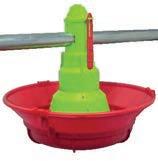



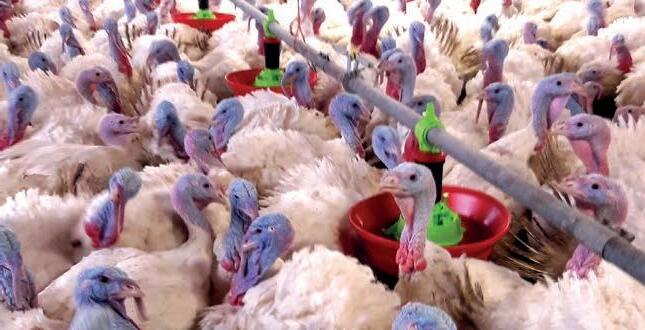
No chick inside the pan.
The feed level adjustment is FULLY AUTOMATIC.
35 - december 2022MANAGEMENT I WANT AZA! QUALITY MADE IN ITALY
MIXTA THE
FOR TURKEYS
FEED PAN
OR MIXED CYCLES
ONE SECOND to open the pan for complete and fast washing.
Flexible rubber shock-proof cone
Model without cover Young birds
MODULA
Via Roma 29, 24030 Medolago (BG) Italy - Phone +39 035 901240 - info@azainternational.it www.azainternational.it
Probiotics, immunity, and gut health
How does the microbiome influence health and what can we do to support it?
As practical diets and husbandry practices shift towards the majority of poultry being raised using ‘no antibiotics ever’ approaches, or other limited antibiotic use situations, probiotics are increasingly popular in poultry diets.
 Elizabeth A. Bobeck, Iowa State University
Elizabeth A. Bobeck, Iowa State University
Probiotics, by definition, are living microorganisms that confer health benefits when administered to the host in adequate amounts. Dead bacteria and their components, certain fibers, and other microorganisms such as yeast can also confer health benefits. Prebiotics, on the other hand, are a group of nutrients that can be degraded by gut microbiota into short chain fatty acids, which interact with the local gastrointestinal tract and can also be used systemically.
Fructooligosaccharides and galactooligosaccharides are the two important groups of prebiotics with beneficial health effects
that are of ten used in combination with probiotics in diets. Probiotics will be the main focus of this talk.
Probiotics have been successfully used to prevent or ameliorate digestive and metabolic disorders, but the mechanism of action of probiotics are diverse, heterogenous, and strain- specific. Mechanisms of action include normalization of perturbed microbial communities, competitive exclusion of pathogens, modulation of biliary salt, short chain fatty acid production, and enzymatic activities, intestinal physiological changes, and immunoregulation.
36 NUTRITION - nutrition -
inclusions. Importantly, because most probiotics do not colonize the host, it is important to use them in a continuous and long-term fashion to see the most benefit.
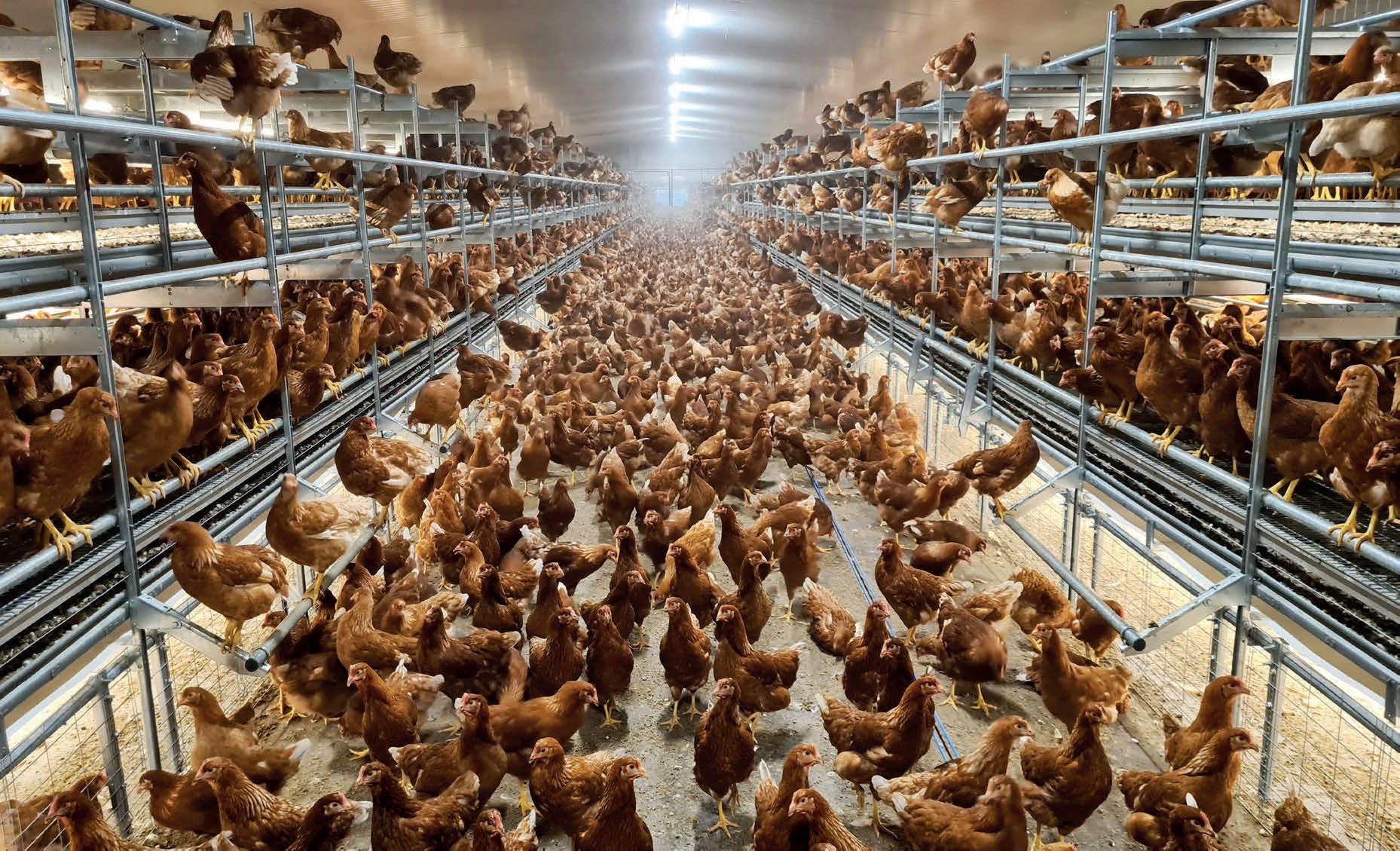
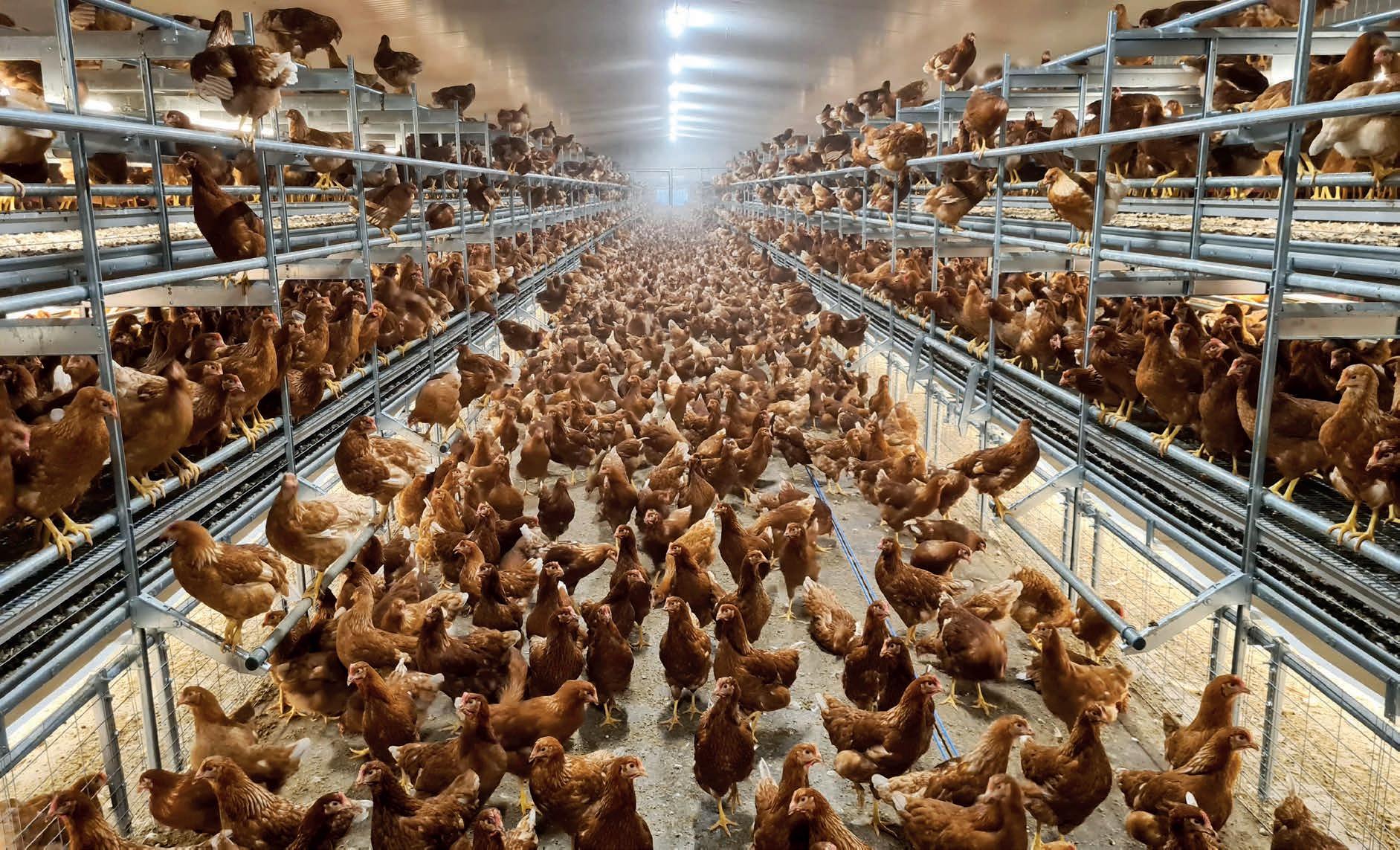
37 - december 2022NUTRITION
From the Proceedings of the Midwest Poultry Forum 2022 Contact us www.facco.net - info@facco.net Marsango di Campo San Martino Padova - Italy +39 049 9698111 60 years of experience in cage free and free range projects all over the world! Cage Free Contact us www.facco.net - info@facco.net Marsango di Campo San Martino Padova - Italy +39 049 9698111
Yuko Sato, DVM, MS, DACPV
Iowa State University, Veterinary Diagnostic and Production Animal Medicine, 2430 Lloyd Vet Med, Ames, IA 50011
Case studies of re-emerging bacterial diseases in cage-free and organic flocks
With almost 30% of US layer production in cage-free1, there are regional or emerging diseases that are starting to be more prevalent in these production systems. Of concern is the increasing numbers of bacterial diseases such as fowl cholera (Pasteurella multocida), infectious coryza (Avibacterium paragallinarum), and spotty liver disease (SLD) (Campylobacter hepaticus).

38 - veterinary scienceVETERINARY SCIENCE












and latest technical and scientific advances at zootecnicainternational.com! VISIT OUR WEBSITE zootecnicainternational.com FOR A DEEP INSIGHT INTO THE POULTRY INDUSTRY! NEW PRODUCTS COMPANY NEWS EVENTS FIELD REPORTS INTERVIEWS MARKET TRENDS PROFILES
According to the 2021 Association of Veterinarians in Egg Production (AVEP) survey, fowl cholera ranked as #8 and infectious coryza ranked #7 out of the top 10 diseases in the cage-free layer industry, with special notice to SLD as an emerging disease (US Animal Health Association national meeting, 2021). Scenarios presented to the lab in the recent year will be discussed as a case study format at the live meeting.
Fowl cholera
Caused by gram negative bacteria, Pasteurella multocida, fowl cholera is an acute bacterial disease that results in sepsis and high mortality in all types of poultry. Mortalities range up to 20%, although even higher rates are reported with secondary infections. Lesions and clinical pictures can mimic Highly Pathogenic Avian Influenza (HPAI), with peritonitis and acute mortality. Survivors maintain within a flock of chickens as chronic and persistent shedders, resulting in nagging mortality and egg production drops in subsequent flocks2. This is especially a problem in multi-age flocks, where all-in-all-out practices cannot be done. Control with vaccination in the face of the outbreak with live vaccination by wing web has met with success in some organic flocks. Antibiotic therapy in conventional flocks has also been successful in the short term but chronic mortality and suppression of production returns after treatment subsides. Increasing the frequency of vaccination is being used preventatively in flocks with a history of outbreaks.
Infectious coryza
Caused by gram negative bacteria, Avibacterium paragallinarum, coryza is another acute bacterial disease that causes severe drops in water and feed consumption, followed by drops in egg production. The disease is highly contagious and once a flock is infected on a multi-age layer site, it is hard to remove unless vaccination and depopulation methods are used. Clinical signs of upper respiratory infection usually are exacerbated by co-infections with other agents such as infectious bronchitis, ILT, colibacillosis —however coryza alone has been reported to cause up to 28% mortality in layer flocks3. Diagnosis is mainly through bacterial culture, which could be challenging. Vaccination is usually a multiple dose regimen during the pullet phase using commercial vaccines and
reported success with autogenous vaccines. Molecular methods using qPCR has been used for diagnosis, although recently there are several reports of positive coryza PCR with the absence of clinical signs.
Spotty Liver Disease (SLD)
Flocks with this condition experience a five to 20% drop in egg production over a three to four-week period and have 0.5 to 5% mortality. Missouri and Arkansas have most of the cases although breaks have been seen in other high density cage-free, outdoor access areas. This is also a major problem in pastured flocks in Australia where the cause was determined to be due to Campylobacter hepaticus. A major vaccine company is producing an autogenous vaccine that is showing great promise in effectively reducing this problem.
References
1 USDA NASS Chickens and Eggs Survey, Accessed February 9th, 2022. https://www.nass.usda.gov/Surveys/ Guide_to_NASS_Surveys/Chickens_and_Eggs/index. php.
2 Blackall, P.J. and C.L. Hofacre. “Fowl cholera.” Pp831889. Swayne, D.E., M. Boulianne, C.M. Logue, L.R. McDougald, V. Nair, D.L. Suarez, S. de Wit, T. Grimes, D. Johnson, M. Kromm, T.Y. Prajitno, I. Rubinoff, G. Zavala. In: Diseases of Poultry, 14th edition. John Wiley & Sons, Inc. 2020.
3 Bland, M.P., A.A. Bickford, B.R. Charlton, G.C. Cooper, F. Sommer and G. Cutler. 2002. Case Report: A severe infectious coryza infection in a multi ‐age layer complex in central California. In: 51st Western Poultry Disease Conference/XXVII Convencion Anual ANECA, Puerto Vallarta, Mexico.
From the Proceedings of Midwest Poultry Federation Pullet/Layer Health Workshop
40 - veterinary scienceVETERINARY SCIENCE
Aviagen Advantage Breeds
The right bird for the right market. Broadest portfolio in the broiler breeding industry. Our unequaled brand diversity will help you meet the needs of your market. Let us show you at aviagen.com.


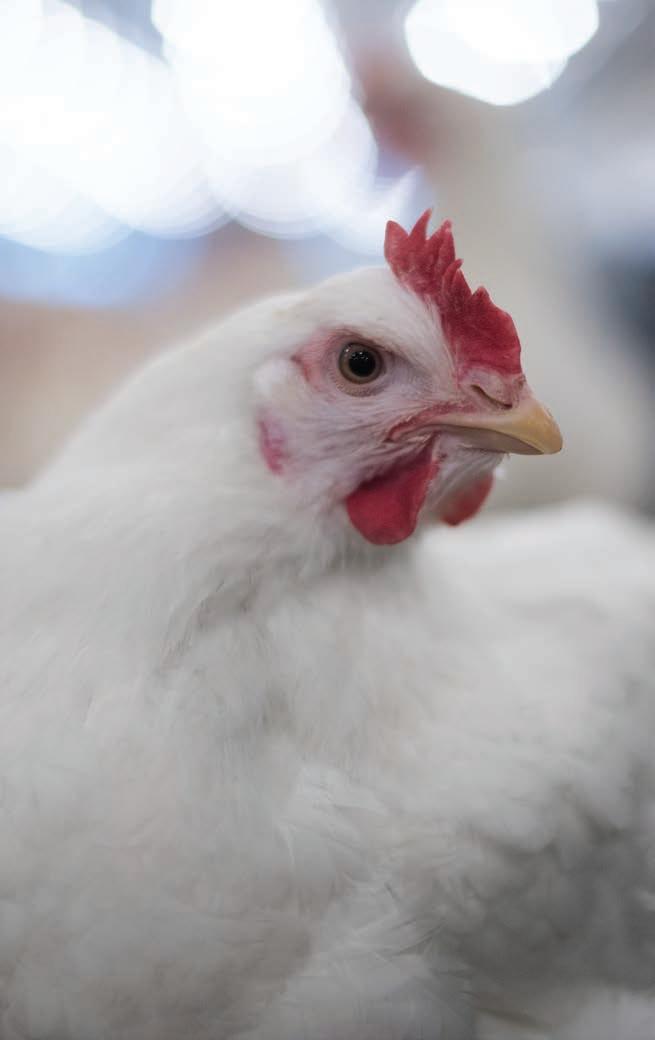
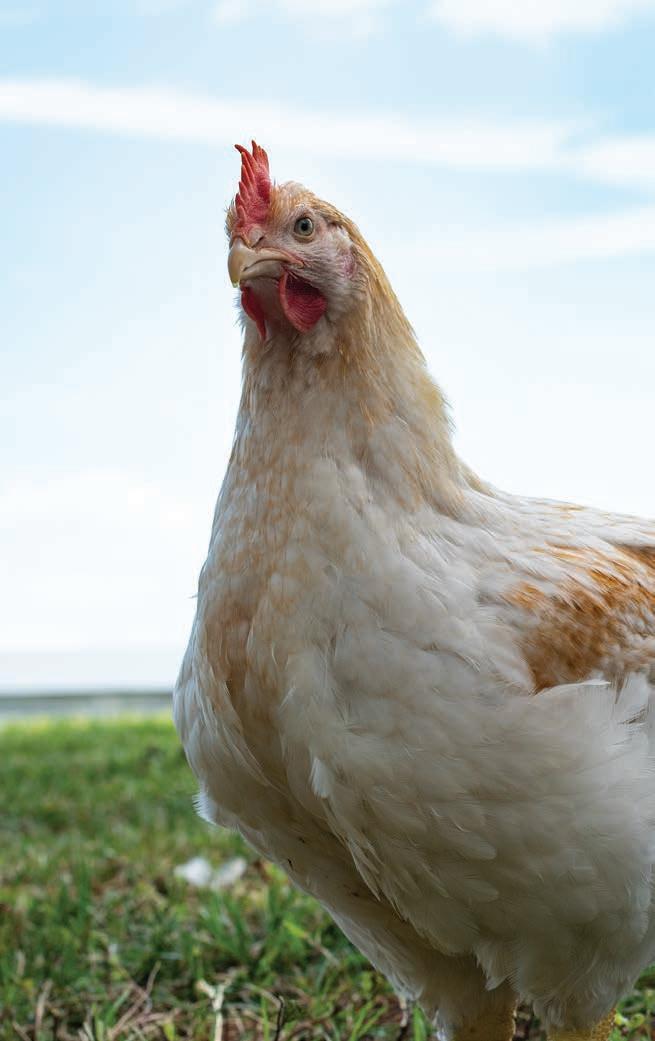
 Eng. Fabio G. Nunes
Poultry Processing Consultant, Brazil fabio.g.nunes@hotmail.com
Eng. Fabio G. Nunes
Poultry Processing Consultant, Brazil fabio.g.nunes@hotmail.com

“The goal of the food safety professionals should be to create a food safety culture not a food safety program”
Frank Yiannas, Deputy Commissioner for Food Policy and Response, Food and Drug Administration, USA
Maintaining the inside-outside bird washer for optimal hygiene
Guaranteeing a high level of hygiene throughout the processing floor is key to safeguard the safety of the products. The role of the hygiene acquires a special dimension along the evisceration line, whose nature of the process makes the carcasses more prone to contamination of different natures. Therefore, a trustable inside-outside bird washer at the end of the line has long-proven to be an efficacious resource in enhancing the carcasses hygiene and henceforth contributing to improve the safety of the final products.
The inside-outside bird washer, or simply IOBW, has long-proven to be a valuable resource in the unending effort of the processing floor to boosting the hygiene of the carcasses.
The IOBW is commonly installed in a 180°-curve at the end of the evisceration line. It aims at washing off as much of the organic, physical, and bacterial contaminants adhered to in-
42 - processingPROCESSING
©Marel
ternal and external surfaces of the carcasses as possible before the chiller, especially the air chiller, to enhance the cleanliness and appearance of the final products.
Carcasses commonly feed the IOBW with breast out, and regardless of its constructive diversity the process consists simply of washing simultaneously and thoroughly the inside and outside surfaces of the carcasses.
The outside washing targets the full front and back surfaces of the carcasses from the feet hocks to the neck skin. It is performed by fixed nozzles installed on two parallel, concentric, and descending spiral-like mounting to allow the washing to be performed from up all way down while carcasses turn around. The inside washing, by its turn, is performed by spear-like nozzles that while descending into the abdominal cavity spray the inner surface with water as carcasses orbits the machine. The spear-like nozzles shower the water in a circle-like or a spiral-like format, and can additionally be equipped with rotating silicon-bristle brushes to scrub the abdominal cavity thus boosting the cleansing capability.
Yet high-pressure water flow IOBW is available, the water-conserving mid-pressure water flow is the most common type used. In such machines, all nozzles are supplied water at 500 to 1200 kPa (5 to 12 bar) that is secured either by the regular water supply line or by means of a dedicated pump. Manufacturers usually recommend operating at 900 kPa (9 bar), though. At this level one might expect a consumption around 7 thousand liters at a speed of 10 thousand carcasses/hour. To guarantee the optimal washing of the carcasses the number of IOBW modules must be compatible with the speed the evisceration line is built for.
As to secure the best IOBW performance and henceforth the hygiene and appearance of the final products, it is crucial to secure its optimal functioning by means of simple yet important daily care:
• 1) Maintenance program: fully adhering to the manufacturer’s maintenance program keeps IOBW always in good physical and operational conditions. Remember that proper maintenance means optimal performance and hygiene.
• 2) Water pipeline filter: adding filters to the water in-feed line prevents pipeline scales, sand grits or others present in the water to clog the nozzles thus reducing the IOBW performance.
• 3) In-feed water flowmeter: in some countries the in-feed water flow is regulated and monitored by the pertinent authorities. Therefore, companies are required to equip the IOBW with a flowmeter. As for all measuring equipments, flowmeters require a periodical calibration to secure its accuracy and trustability.
• 4) Hydraulic hoses: these simple portions of the IOBW are determinant for its proper functioning. Yet a sturdy, durable component, they were down over time and need to be readily replaced when damaged.
• 5) Water leakages: check IOBW regularly for water leaks and replace damaged, wore down rings, gaskets, or other parts to save water.
• 6) Nozzles: all nozzles ought to be periodically removed and cleaned for optimal performance. The outer nozzles must be replaced in the same original position after the needle-cleaning; the nozzles on the spears’ heads might be compressed air-blown cleaned or using a compatible plastic rod.
• 7) Lubrication: IOBW demand periodical lubrication using either edible oil or grease. The practice secures the smooth functioning of the machine while extends the life of the moving parts.
Yet simple in its operational concept the IOBW is a crucial piece of equipment inside the plant for its close relationship with the hygiene of the process and safety of the products. Therefore, companies must do its best to secure its intactness and operational capabilities.
Literature available from author upon request
43 - december 2022PROCESSING
World leader in incubators & complete hatchery solutions




www.petersime.com
Incubators for all types of eggs. Specialists for partridges, pheasants and ostriches. Via Bancora e Rimoldi 3 – 22070 Guanzate (COMO), Italy 39-031.352.91.22 – 031.352.91.29 - Fax: 39-031.352.95.91 victoria@victoria-srl.com
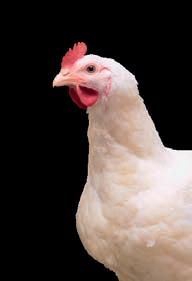

Automatic and digital incubators from 18 to 10.000 eggs of capacity Via G.Galilei 3 – 22070 Guanzate (COMO), Italy - Fax: +39-031.899.163





E-mail: fiem@fiem.it






INCUBATORS SPECIALIST SINCE 1924
aviagen.com Great Achievements, Great Numbers 2020 - Arbor Acres Zootecnica Magazine Market Guide Ad - ENGLISH.indd 1 2/10/20 1:38 PM Reliable Breeder, Resilient Broiler aviagen.com aviagen.com ROSS 308 DELIVERS Ross Zootecnica Magazine Market Guide Ad - ENGLISH.indd2/10/201 1:34 PM info@cobbvantress.com The Chicken Experts. aviagen.com zootecnicainternational.com Breeders Hatcheries
www.agritech.it – e-mail: commerce@agritech.it
Leader in pig & poultry equipment


THE MOST INNOVATIVE RANGE FOR POULTRY FEEDING


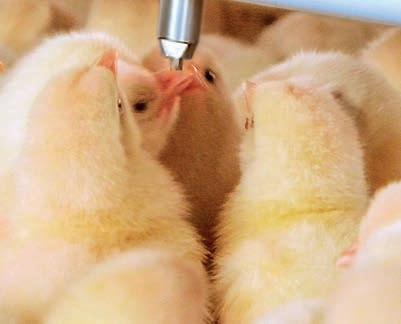
Via Roma 29, 24030 Medolago (BG) Italy - Phone +39 035 901240 Fax +39 035 902757 info@azainternational.it www.azainternational.it
Equipment
Egg Sanitation Worldwide


The key to superior egg sanitation

www.MSTegg.com

info@MSTegg.com

+44 (0)1536 516778 (UK)
+1 423-881-3882 (USA)
CARFED INTERNATIONAL LTD

Italian headquarters: Piazza Oberdan, 3, 20129 Milano (Italy)
Italian warehouse: Via Basilicata, 10, 20098 San Giuliano Milanese (Italy)
Tel.: +39 02 9881140 - Fax: +39 02 98280274
Email: carfed@carfed.it - Website: www.carfed.it
UK headquarters: Ground Floor, One George Yard, London EC3V 9DF, England, UK
Тel.: + 44. 20. 7660.0987- Email: carfed@carfed.co.uk
CODAF Poultry Equipment Manufacturers
Via Cavour, 74/76 • 25010 Isorella (Brescia), ITALY
Tel. +39 030 9958156 • Fax: +39 030 9952810 info@codaf.net • www.codaf.net
www.bigdutchman.de
The No. 1 worldwide POULTRY EQUIPMENT
BELTS AND ROPES FOR AVICULTURAL US E Manure removal belts an d Manure belt with holes for drying system s
• Watering & Feeding Systems
• Poultry Accessories

• Industry Breeding
• Manure & Egg Belts
Corti Zootecnici Srl | Via Volta 4, Monvalle (VA) - Italy| Tel. +39 0332 799985 | info@cortizootecnici.com
Via Garibaldi, 54 – 26040 Scandolara Ravara (CR) Italy Tel. (+39) 0375/95135 • Fax. (+39) 0375/95169 info@barbieri-belts.com • www.barbieri-belts.com
TURNKEY PROJECTS
POULTRY INTEGRATED PROJECTS
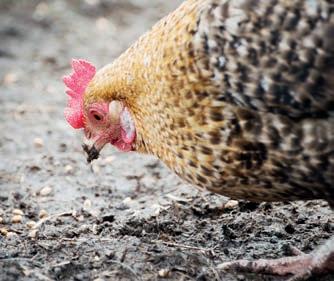
POULTRY EQUIPMENT FOR BROILERS AND LAYERS AVIARY SYSTEMS
Officine Facco & C. S.p.A. Via Venezia, 30 - Marsango (PD) Italy
Tel. +39 049 9698111 - Fax +39 049 9630605 | www.facco.net - facco@facco.net
spazio55x45-facco.indd 2 03/10/14 15:06
BD Ad Zootecnica 55x95 10-13.indd 1 22.10.13 14:24
GmbH & Co. KG
Dassendaler Weg 13 • D-47665 Sonsbeck (Germany)
T: +49 (0) 2838 912-0 • F: +49 (0) 2838 2791 info@specht-tenelsen.de • www.specht-tenelsen.de
POULTRY EQUIPMENT MANUFACTURERS






VALLI spa • via Cimatti, 2 • 47010 Galeata (FC) • Italy
T: +39 0543 975 311 • F: +39 0543 981 400
E: info@valli-italy.com • I: www.valli-italy.com
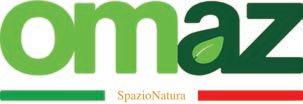
Housing equipment for breeders, layers and broilers.
www.vencomaticgroup.com
Let’s talk about water
impex nl
Drinking systems for chicks, broilers, breeders, layers, ducks, turkeys, rabbits and pigs


Conveyor systems for egg collection
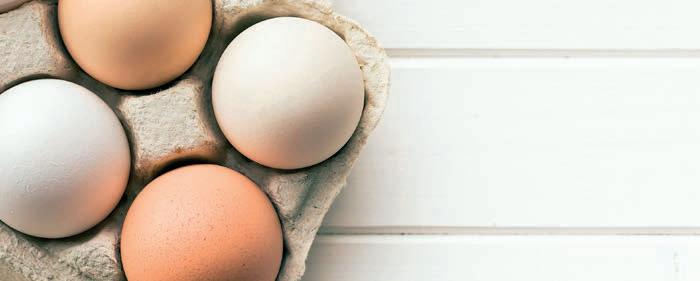
Climate systems: Pad Climate (evaporative cooling for paper or plastic pads) and Top Climate (with high pressure nozzles)
LUBING via Marco Polo, (Z.I.)
info@lubing.it www.lubingsystem.com
THE BEST FOR YOUR EGGS!
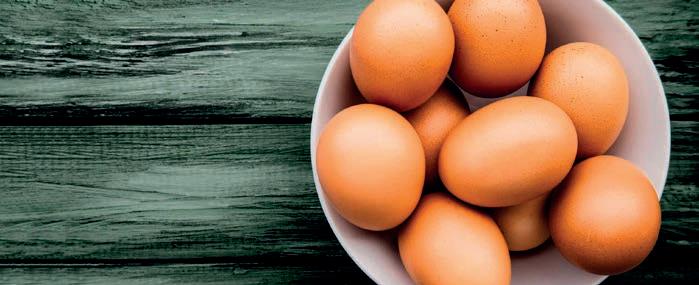
via San Lorenzo, 9b
35010 Campo San Martino (PD), Italy
Ph: +39.049.9620774

Web: www.flexy.it - Email: info@flexy.it

Campodarsego,
+ fax +
Padova Italy tel.
SISTEM SRL lubingsystem.com
Equipment
UPCOMING EVENTS 2023
January, 24 to 26
IPPE
International Production & Processing Expo
Georgia World Congress Center 285 Andrew Young International Blvd NW
Atlanta, Georgia, USA
For information contact:
U.S. Poultry & Egg Association 1530 Cooledge Road
Tucker, GA, USA
Tel.: +1 770 4939401
Fax: +1 770 4939257
Email: pstates@ippexpo.org
Website: www.ippexpo.org
March, 8 to 10
VIV ASIA
International trade show from feed to food for Asia
IMPACT Exhibition Center
Bangkok, Thailand
For information contact:
Worldwide
VNU Exhibitions Europe
Tel.: +31 (0) 30 295 2700
Fax: +31 (0) 30 295 2809
South East Asia
VNU Exhibitions Asia Pacific Co., Ltd.
88 The PARQ, 4th Fl., West Wing
Ratchadaphisek Rd., Khlong Toei, Bangkok 10110 Thailand
Tel.: +662 111 6611
Email: viv@vnuasiapacific.com
Website: vivasia.nl
May, 3 to 5
Fieravicola
International Poultry Exhibition
Rimini Expo Centre, Rimini, Italy
For information contact:
Fieravicola S.R.L.
Via Emilia, 155
47921 Rimini (RN) - Italy
Tel.: +39 0547 1877115
Email: info@fieravicola.com
May, 30 to June 1
Meat and Poultry Industry Russia
From Feed to Food
Crocus Expo
Moscow, Russia
For information contact:
Email: info@meatindustry.ru
Website: meatindustry.ru
July, 8 to 10
VIV TURKEY
International trade fair for poultry technologies
Istanbul Expo Center
Istanbul, Turkey
For information contact:
Mrs Hande Çakıcı
Tel.: +90 212 216 4010
Fax: +90 212 216 3360
Email: hande@hkf-fairs.com
Website: www.vivturkey.com
June, 21 to 24
23rd European Symposium on Poultry Nutrition - ESPN 2023
Palacongressi Rimini
Rimini, Italy
For information contact: VET International S.r.l.
Milan, Italy
Email: espn2023@vetinternational.eu
espn2023sponsor@vetinternational.eu
Website: www.espn2023.eu
September, 12 to 14
SPACE 2023
Parc-Expo Rennes
Rennes Cedex, France
For information contact:
Tel.: +33 (0) 2 23 48 28 80
Email: info@space.fr
Website: www.space.fr
November, 20 to 22
VIV MEA
International Trade Show From Feed To Food for The Middle East and Africa
ADNEC, Abu Dhabi
United Arab Emirates
For information contact: Organizer VIV worldwide
VNU Exhibitions Europe
P.O.Box 8800
3503 RV Utrecht, the Netherlands
Tel.: +31 (0) 30 295 2999
Email: viv.mea@vnuexhibitions.com
Website: www.vivmea.nl
Venue
Abu Dhabi National Exhibitions Company (ADNEC)
Khaleej Al Arabi Street
P.O. Box 5546
Abu Dhabi, United Arab Emirates
Tel.: 800 23632 and international +971 (0) 2 444 6900
Fax: +971 (0) 2 444 6135
Website: www.adnec.ae
INTERNET GUIDE
Agritech commerce@agritech.it
Arion Fasoli info@arionfasoli.com
Aviagen info@aviagen.com
Aviagen Turkeys Ltd turkeysltd@aviagen.com
Aza International info@azainternational.it
Barbieri Belts info@barbieri-belts.com
Big Dutchman big@bigdutchman.com
Biochem info@biochem.net
Carfed International Ltd carfed@carfed.co.uk
Carfed Italian Branch carfed@carfed.it
Cobb Europe info@cobb-europe.com
Codaf info@codaf.net
Corti Zootecnici S.r.l. info@cortizootecnici.com
DACS mail@dacs.dk
EuroTier eurotier@dlg.org
Facco Poultry Equipment facco@facco.net
FIEM fiem@fiem.it
FierAgricola Verona fieragricola@veronafiere.it
FierAvicola info@fieravicola.com
Gasolec sales@gasolec.com
Giordano Poultry Plast info@poultryplast.com
GI-OVO B.V. sales@gi-ovo.com
Hendrix Genetics info@hendrix-genetics.com
Hubbard contact.emea@hubbardbreeders.com
Hy-Line International info@hyline.com
Impex Barneveld BV info@impex.nl
Intracare info@intracare.nl
Jamesway sales@jamesway.com
Jansen Poultry Equipment info@jpe.org
Lubing System info@lubing.it
Marel Poultry info.poultry@marel.com
Mbe Breeding Equipment info@mbefabriano.it
Menci commerciale@menci.it
Meyn sales@meyn.com
MOBA sales@moba.net
MS Technologies info@mstegg.com
Newpharm info@newpharm.it
Officine Meccaniche Vettorello luciano@officinevettorello.it
Omaz srl omaz@omaz.com
Petersime N.V. info@petersime.com
Prinzen B.V. info@prinzen.com
Reventa info.reventa@munters.de
Royal Pas Reform info@pasreform.com
www.agritech.it
www.arionfasoli.com
www.aviagen.com
www.aviagenturkeys.com
www.azainternational.it
www.barbieribelts.com
www.bigdutchman.de
www.biochem.net
www.carfed.it
www.cobb-vantress.com
www.codaf.net
www.cortizootecnici.it
www.dacs.dk
www.eurotier.com
www.facco.net
www.fiem.it
www.fieragricola.it
www.fieravicola.com
www.gasolec.com
www.poultryplast.com
www.gi-ovo.com
www.hendrix-genetics.com
www.hubbardbreeders.com
www.hyline.com
www.impex.nl
www.intracare.nl
www.jamesway.com
www.jpe.org
www.lubingsystem.com
www.marel.com/en/poultry
www.mbefabriano.it
www.menci.it
www.meyn.com
www.moba.net
www.mstegg.com
www.newpharm.it
www.officinevettorello.com
www.omaz.com
www.petersime.com
www.prinzen.com
www.reventa.de
www.pasreform.com
Roxell info@roxell.com www.roxell.com
Ska ska@ska.it www.skapoultryequipment.com
Socorex socorex@socorex.com www.socorex.com
Space info@space.fr
Specht Ten Elsen GmbH & Co. KG info@specht-tenelsen.de
Sperotto S.p.A. info@sperotto-spa.com
www.space.fr
www.specht-tenelsen.de
www.sperotto-spa.com
TPI-Polytechniek info@tpi-polytechniek.com www.tpi-polytechniek.com
Val-co intl.sales@val-co.com www.val-co.com
Valli info@valli-italy.com www.valli-italy.com
VDL Agrotech info@vdlagrotech.nl www.vdlagrotech.com
Vencomatic Group B.V. info@vencomaticgroup.com www.vencomaticgroup.com
Victoria victoria@victoria-srl.com www.incubatricivictoria.com
VIV Europe viv.europe@vnuexhibitions.com www.viveurope.nl
Editorial Director Lucio Vernillo
Editorial Staff
Daria Domenici (zootecnica@zootecnica.it)
Account Executive Marianna Caterino (amministrazione@zootecnica.it)
Editorial Office
Zootecnica International
Vicolo Libri, 4
50063 Figline Incisa Valdarno (FI) Italy
Tel.: +39 055 2571891
Website: zootecnicainternational.com
Licence
Registrazione Tribunale di Firenze n.3162
Spedizione in A.P. Art.2 comma 20/B legge 662/96 - Filiale di Firenze
ISSN 0392-0593
Subscription Rates (1 year / 11 issues): Europe Euro 100
Rest of the World Euro 120
Subscribe online by Credit Card or Paypal: zootecnicainternational.com/subscription
Subscribe by money transfer:
1. effect a money transfer to: Zootecnica International, Vicolo Libri, 4
50063 Figline Incisa Valdarno (FI) Italy; bank: UNICREDIT, BIC: UNICRITM1OU9
Iban: IT 81 H 02008 38083 000020067507
2. send us your complete shipping address by email: amministrazione@zootecnica.it.
Art Direction & Layout
Laura Cardilicchia – elleciwebstudio.com
Cover Image: © Denise Vernillo
Printed Nova Arti Grafiche, Florence
English Edition Year XLIV December 2022
Giordano Poultry Plast® products are suitable for several poultry sector species. All the cages and boxes of Poultry Plast are strong and durable, hygienic and easy to clean. Animal welfare is guaranteed thanks to excellent ventilation, easy stacking, as well as smooth and round surfaces that minimize bruises and broken wings, preventing injuries during coop handling. The coop line is very simple to assemble: push fitself locking.

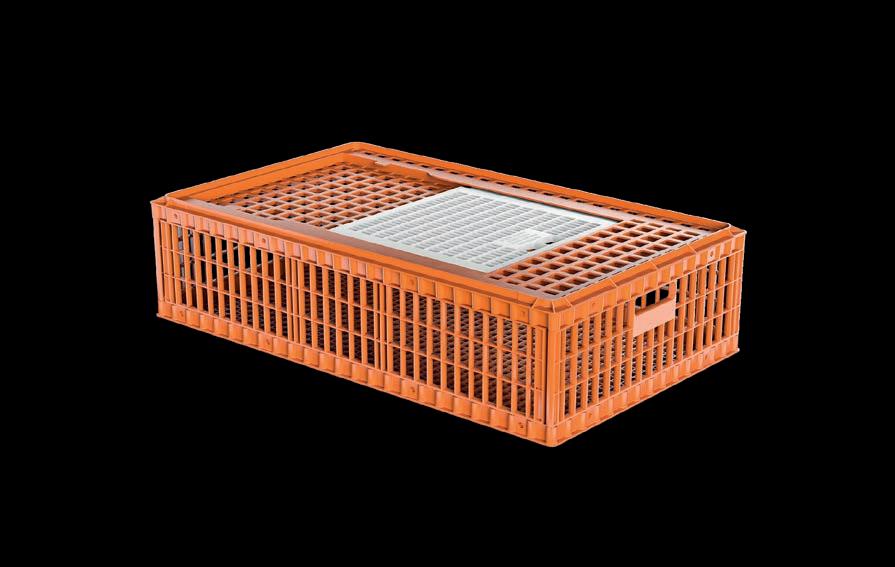
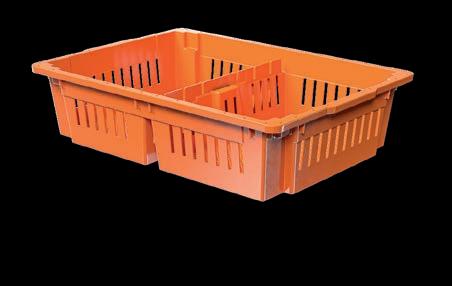

www.poultryplast.com



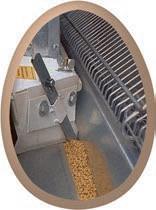

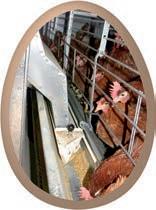












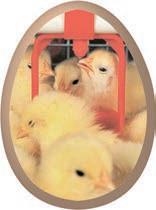













ORIGINAL POULTRY EQUIPMENT GmbH & Co. KG Dassendaler Weg 13 • D-47665 Sonsbeck (Germany) Telefon +49 (0) 2838 912-0 • Telefax+49 (0) 2838 2791 info@specht-tenelsen.de • www.specht-tenelsen.de ® • Cage floor • Group cage system (enriched cage) • Egg belt • Layer battery • Egg collecting system • Manure drying system • Rearing in cages • Rearing in aviary system • Feeding system SPECHT is everywhere hens are! ORIGINAL eco and livestock friendly • Layers in Varia-System where
































































 Hans-Wilhelm Windhorst
Hans-Wilhelm Windhorst















 Elizabeth A. Bobeck, Iowa State University
Elizabeth A. Bobeck, Iowa State University



















 Eng. Fabio G. Nunes
Poultry Processing Consultant, Brazil fabio.g.nunes@hotmail.com
Eng. Fabio G. Nunes
Poultry Processing Consultant, Brazil fabio.g.nunes@hotmail.com




































































